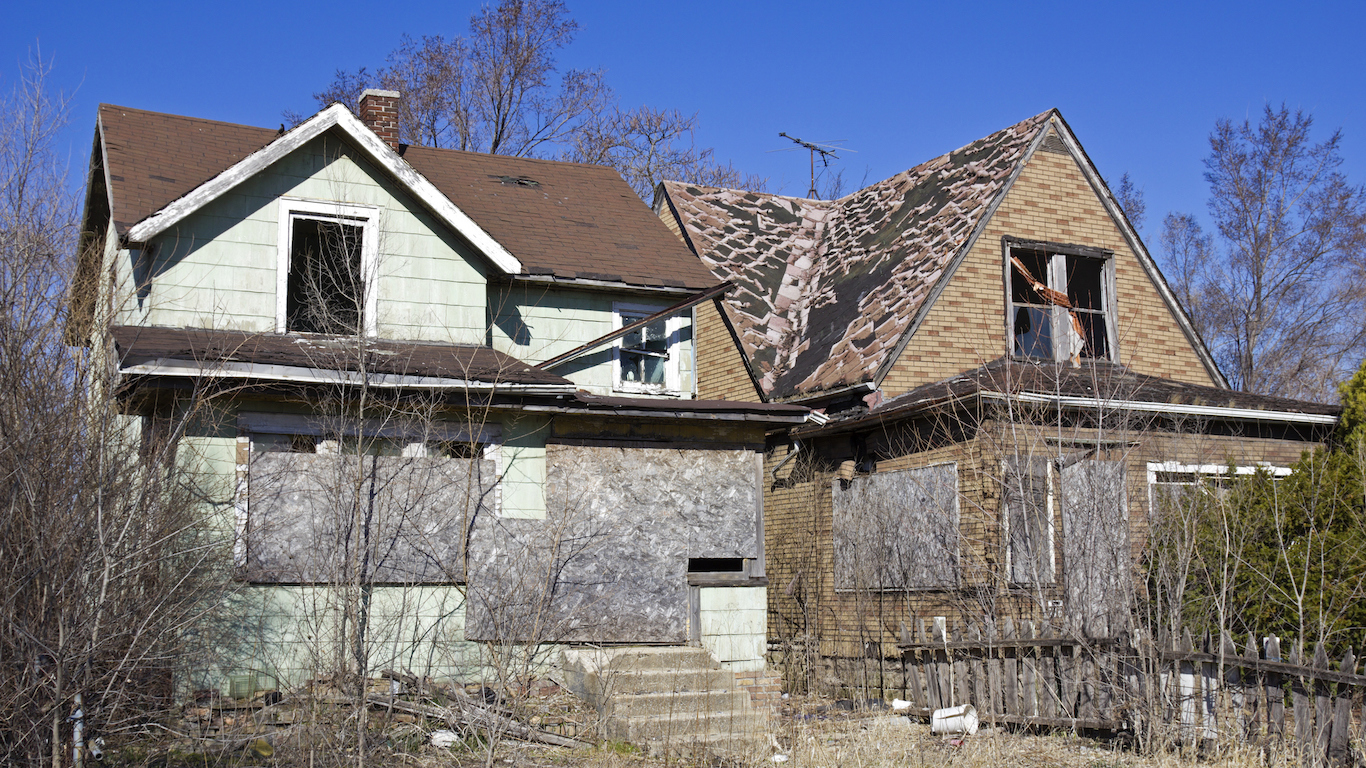
The U.S. median household income reached its highest level in 2019 since record keeping began decades ago.. Yet incomes nationwide are not evenly distributed. In fact, income inequality is at its highest level in over 50 years, as the highest earning 20% of families in the U.S. made 52% of all income in 2018.
This economic disparity is not confined to certain parts of the country. Each of the lower 48 states is home to at least one major city where the typical household earns less than the typical American household.
Using data from the Census Bureau’s 2019 American Community Survey, 24/7 Wall St. identified America’s poorest city in every state. We considered all 621 U.S. cities, towns, villages, municipalities, and Census designated places with available data. Vermont, West Virginia, and Wyoming have no cities covered in the latest Census release and were excluded from the analysis.
Supplemental data on median home value, the percentage of adults age 25 and older with at least a bachelor’s degree, and unemployment also came from the ACS.
The economic struggle of these cities have likely worsened over the past few months, amid the COVID-19 pandemic. The lowest earners have been disproportionately affected by the economic downturn, losing their jobs at a much higher rate than higher-earning workers. This has resulted in a number of cities reporting July unemployment rates in excess of 15% or even 20%, compared to the 10.2% national unemployment rate that month. These are the cities with the worst unemployment crisis right now.
The vast majority of cities that rank as the poorest in their state have relatively low shares of adult residents with college degrees compared to the state and the country as a whole. College-educated adults tend to earn higher wages and are less likely to be unemployed compared to workers without a college degree. These are the most and least educated states.
Click here to see the poorest city in every state.
Click here to see our methodology.
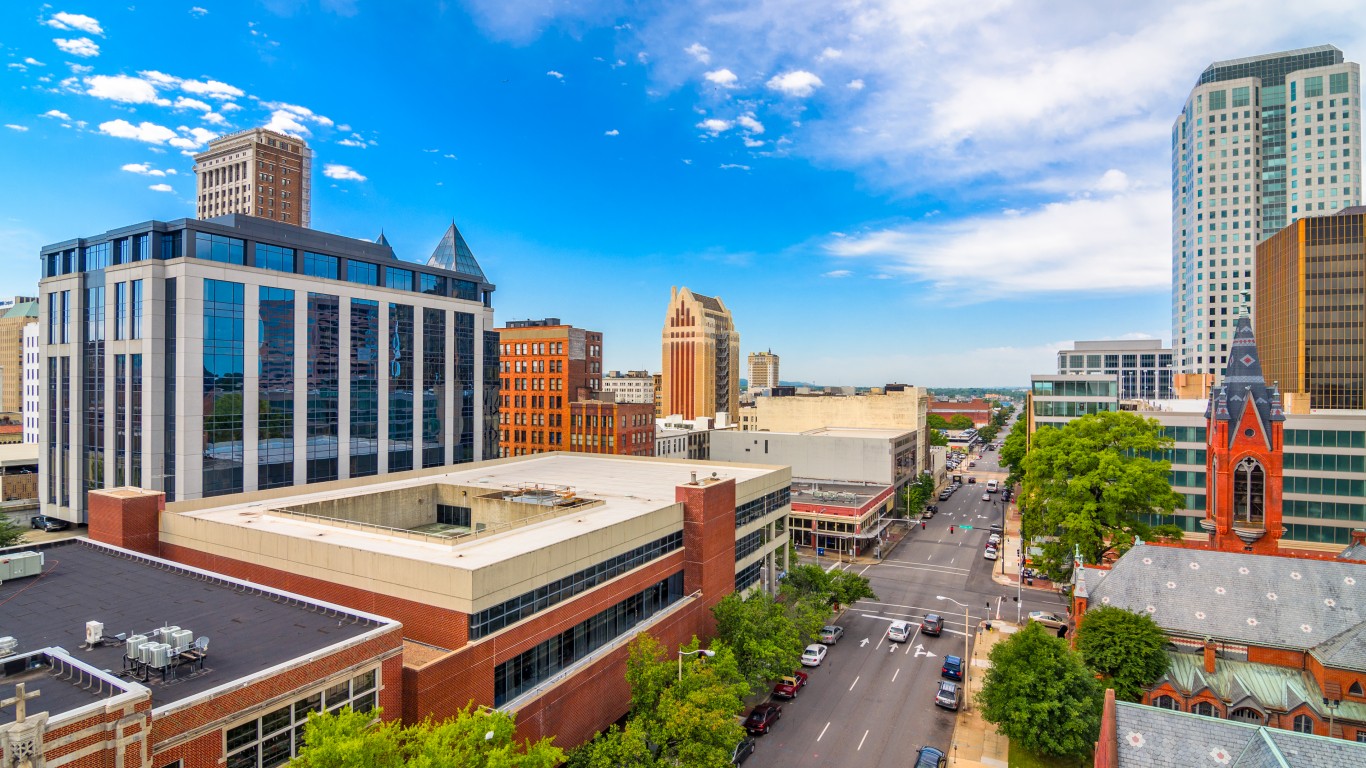
Alabama: Birmingham
> Median household income: $36,753 (state: $51,734)
> Poverty rate: 25.2% (state: 15.5%)
> Median home value: $98,800 (state: $154,000)
> Adults with a bachelor’s degree: 29.5% (state: 26.3%)
> 2019 unemployment rate: 7.3% (state: 4.9%)
> Population: 210,080
The median annual household income in Birmingham, Alabama, is $36,753 — the lowest of any major city in Alabama and nearly $15,000 lower than the state’s median. It is the only one of Alabama’s eight major cities with a median household income below $40,000.
More than a quarter of Birmingham residents live below the poverty line, well above the 15.5% Alabama poverty rate and the 12.3% U.S. poverty rate. Nationwide, 5.8% of households live on less than $10,000 per year. In Birmingham, 16.5% of households live on that income level, the seventh highest share of any major city in the country.
[in-text-ad]

Alaska: Anchorage
> Median household income: $82,716 (state: $75,463)
> Poverty rate: 10.1% (state: 10.1%)
> Median home value: $314,600 (state: $281,200)
> Adults with a bachelor’s degree: 36.3% (state: 30.2%)
> 2019 unemployment rate: 5.4% (state: 5.8%)
> Population: 288,000
Anchorage is the only city in Alaska for which the Census ACS has 2019 data, and it ranks as the poorest city in the state by default only. The typical household in the city earns an income of $82,716 a year — over $7,000 more than the typical Alaska household income.
Though household incomes in Anchorage tend to be higher than household incomes in Alaska overall, the city’s poverty rate still aligns with the state’s poverty rate of 10.1%. This is well below the U.S. poverty rate of 12.3%.
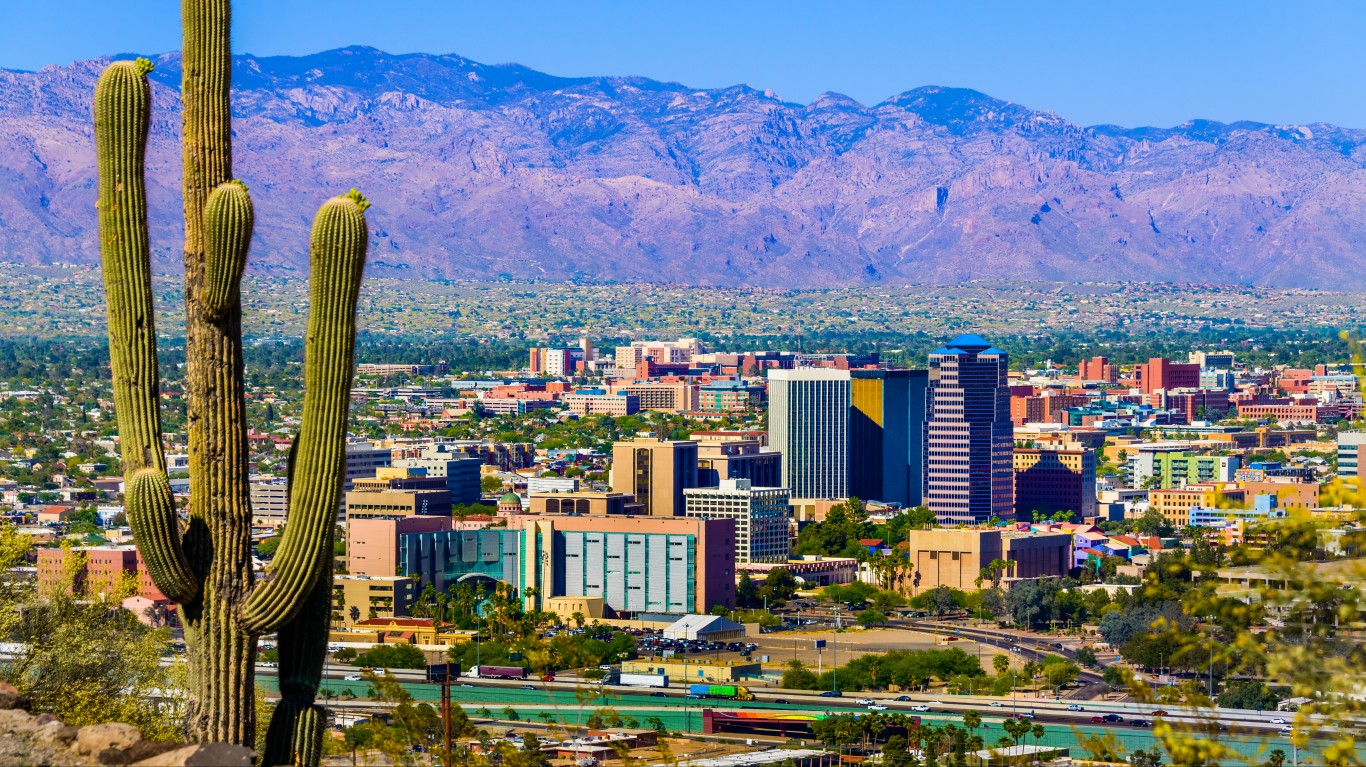
Arizona: Tucson
> Median household income: $44,365 (state: $62,055)
> Poverty rate: 19.1% (state: 13.5%)
> Median home value: $172,700 (state: $255,900)
> Adults with a bachelor’s degree: 27.3% (state: 30.2%)
> 2019 unemployment rate: 6.3% (state: 5.1%)
> Population: 548,082
Tucson is the second largest city in Arizona after Phoenix, with over half a million residents. Some 19.1%, or over 100,000 Tucson residents, live in poverty. Tucson has the lowest median household income of Arizona’s 17 major cities, with the typical household living on $44,365 a year.
Workers with a college degree tend to earn more than those without. In Tucson, 27.3% of adults 25 and older hold a college degree, compared to 30.2% of Arizona adults and 33.1% of American adults of the same age group.

Arkansas: North Little Rock
> Median household income: $40,870 (state: $48,952)
> Poverty rate: 18.8% (state: 16.2%)
> Median home value: $138,800 (state: $136,200)
> Adults with a bachelor’s degree: 28.7% (state: 23.3%)
> 2019 unemployment rate: N/A (state: 4.8%)
> Population: 65,899
The typical household in North Little Rock earns just $40,870 annually, about $8,000 less than the typical household in the state and neary $25,000 less than the typical household nationwide. North Little Rock residents are also far more likely to live below the poverty line than most Americans. Nearly 19% of the local population lives below the poverty line, compared to 16.2% of people living in the state and 12.3% of Americans nationwide.
[in-text-ad-2]

California: Hemet
> Median household income: $39,653 (state: $80,440)
> Poverty rate: 19.1% (state: 11.8%)
> Median home value: $231,900 (state: $568,500)
> Adults with a bachelor’s degree: 10.4% (state: 35.0%)
> 2019 unemployment rate: 10.1% (state: 5.1%)
> Population: 85,341
Hemet, about 75 miles east of Los Angeles, is by far the poorest of California’s 142 major cities. The city’s median household income of $39,653 is more than $10,000 lower than the next closest city, San Bernardino. The typical household in Hemet earns less than half of what the typical California household does.
Hemet residents are much more likely to live in poverty compared to California residents overall, as 19.1% of residents live below the poverty line compared to 11.8% of residents statewide. City workers are also nearly twice as likely to be unemployed as the typical Californian worker. Due to these economic struggles more residents likely need help with basic needs. Some 16.1% of Hemet households received food stamps in the past 12 months, compared to 8.4% of state households and 10.7% of American households.

Colorado: Pueblo
> Median household income: $43,148 (state: $77,127)
> Poverty rate: 22.9% (state: 9.3%)
> Median home value: $159,800 (state: $394,600)
> Adults with a bachelor’s degree: 20.2% (state: 42.7%)
> 2019 unemployment rate: 6.7% (state: 3.7%)
> Population: 112,357
The median household income in Pueblo, Colorado, of $43,148 is well short of the state’s median household income of $77,127. Of Colorado’s 16 major cities, Pueblo is the only one with a median annual household income of less than $60,000.
Workers with a college degree tend to have higher incomes and lower unemployment rates than workers with lower levels of education. Pueblo has by far the lowest bachelor’s degree attainment rate of any Colorado city, at 20.2% — less than half of the state’s rate. Nearly 23% of Pueblo residents live below the poverty line, compared to 9.3% of Colorado residents overall.
[in-text-ad]
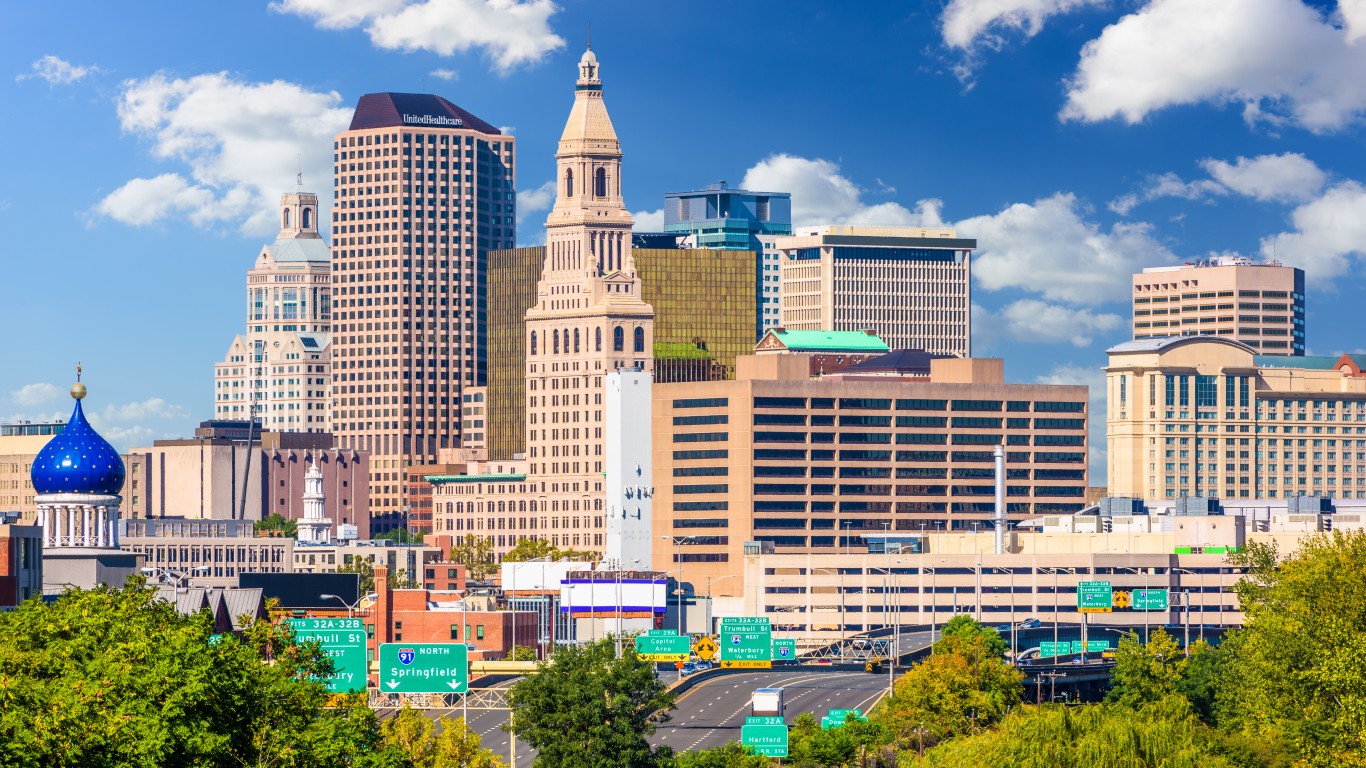
Connecticut: Hartford
> Median household income: $36,762 (state: $78,833)
> Poverty rate: 27.1% (state: 10.0%)
> Median home value: $173,500 (state: $280,700)
> Adults with a bachelor’s degree: 14.8% (state: 39.8%)
> 2019 unemployment rate: 10.6% (state: 5.3%)
> Population: 122,107
Hartford is the poorest city in Connecticut and the 18th poorest city in the entire country, with a median household income of $36,762. Connecticut is one of the most educated states in the country, with nearly 40% of adults 25 and older holding a bachelor’s degree or higher. Yet Hartford has one of the nation’s lowest bachelor’s degree attainment rates, as fewer than 15% of adult residents finished college.
More than a quarter of Hartford residents live below the poverty line, far exceeding the state’s poverty rate of 10% and the national poverty rate of 12.3%. The city’s unemployment rate is twice as high as the state’s 5.3% unemployment rate — both of which are higher than the 4.5% U.S. annual unemployment rate.

Delaware: Wilmington
> Median household income: $47,722 (state: $70,176)
> Poverty rate: 29.8% (state: 11.3%)
> Median home value: $174,400 (state: $261,700)
> Adults with a bachelor’s degree: 29.0% (state: 33.2%)
> 2019 unemployment rate: 7.3% (state: 4.6%)
> Population: 70,164
As the only major city in Delaware, Wilmington is the poorest city in the state by default. Still, like many other cities on this list, the city’s median household income of $47,722 is well below the state’s median of $70,176. Wilmington’s bachelor’s degree attainment rate of 29.0% is only slightly lower than the state’s rate of 33.2%. Yet the city’s poverty rate of 29.8% is nearly three times as high as the state’s poverty rate of 11.3%.
In Wilmington, 16.3% of households live on $10,000 per year or less, the 10th highest percentage in the country and well above the 5.8% share nationwide.
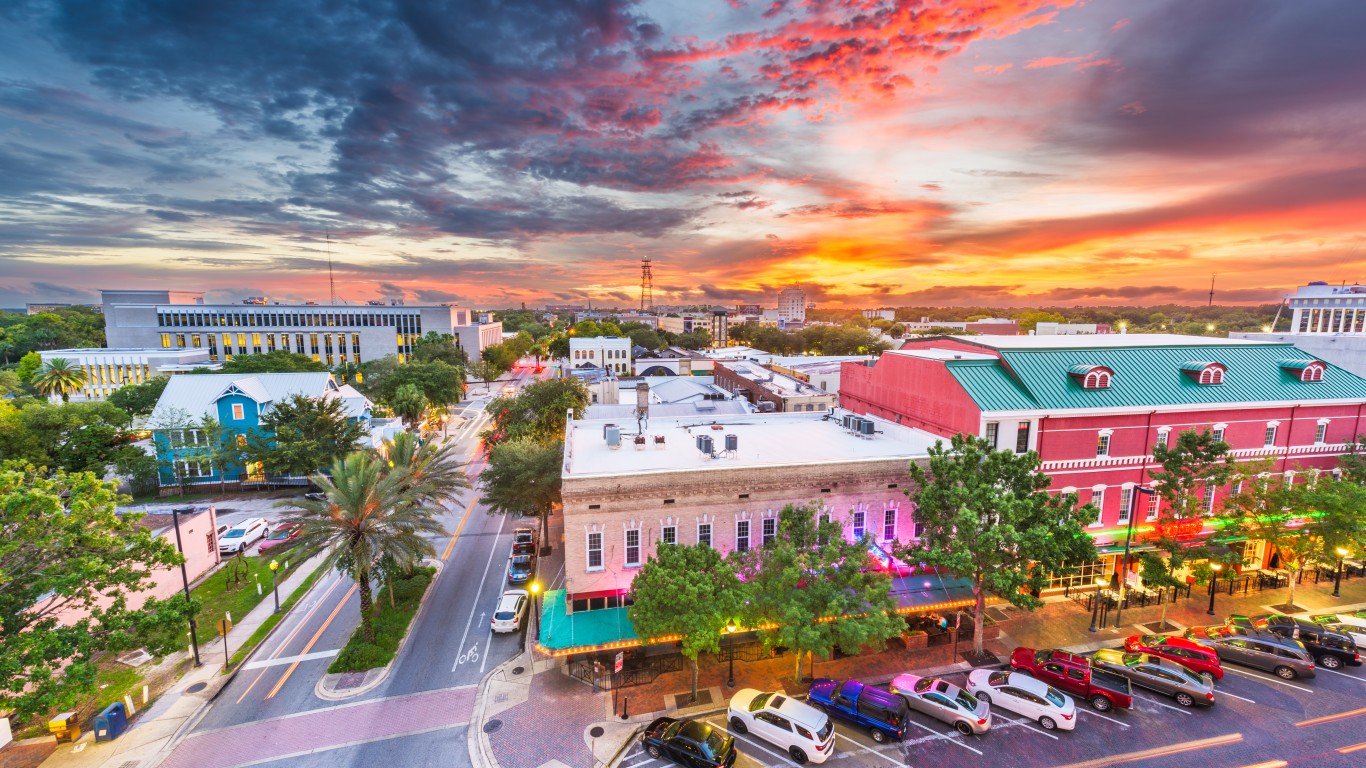
Florida: Gainesville
> Median household income: $39,201 (state: $59,227)
> Poverty rate: 26.1% (state: 12.7%)
> Median home value: $187,200 (state: $245,100)
> Adults with a bachelor’s degree: 46.1% (state: 30.7%)
> 2019 unemployment rate: 3.6% (state: 4.5%)
> Population: 133,990
Gainesville, located in Northern Florida, is the poorest city in the state, with a median annual household income that is more than $20,000 below Florida’s median of $59,227. Gainesville has a 26.1% poverty rate, more than double Florida’s 12.7% poverty rate.
Workers with college degrees tend to earn more than workers with lower levels of education. Gainesville still ranks as Florida’s poorest city despite being one of its most highly educated, with 46.1% of those 25 and older holding at least a bachelor’s degree. Gainesville is home to the University of Florida, and students in cities with large universities often skew poverty data.
[in-text-ad-2]

Georgia: Albany
> Median household income: $31,397 (state: $61,980)
> Poverty rate: 31.0% (state: 13.3%)
> Median home value: $108,400 (state: $202,500)
> Adults with a bachelor’s degree: 17.3% (state: 32.5%)
> 2019 unemployment rate: 12.5% (state: 4.8%)
> Population: 70,643
Albany, Georgia’s 2019 unemployment rate is not only the highest in the state, but also the sixth highest in the entire country, at 12.5%. This is well beyond the state’s 4.8% unemployment rate and national 4.5% unemployment rate. This lack of jobs may contribute to Albany’s state-lowest $31,397 median household income.
Albany also has one of the 10 highest poverty rates of U.S. cities, at 31%. It also ranks fifth in the country in the percentage of households living on less than $10,000 per year, at 17.6%, more than triple the U.S. share.

Hawaii: Urban Honolulu
> Median household income: $72,943 (state: $83,102)
> Poverty rate: 9.4% (state: 9.3%)
> Median home value: $754,700 (state: $669,200)
> Adults with a bachelor’s degree: 38.6% (state: 33.6%)
> 2019 unemployment rate: 3.8% (state: 3.9%)
> Population: 345,055
Honolulu is the only city in Hawaii for which the Census ACS has 2019 data, and it ranks as the poorest city in the state by default only. The typical Honolulu household has an income of $72,943 a year, well below the median income across the state of $83,102. Despite lower incomes overall, Honolulu residents are not necessarily more likely than the typical Hawaiian to face serious financial hardship. The city’s poverty rate of 9.4% is in line with the 9.3% statewide rate.
Additionally, although Honolulu’s median household income is lower than the state as a whole, it is well above the $65,712 national median.
[in-text-ad]

Idaho: Nampa
> Median household income: $57,352 (state: $60,999)
> Poverty rate: 7.8% (state: 11.2%)
> Median home value: $214,000 (state: $255,200)
> Adults with a bachelor’s degree: 21.2% (state: 28.7%)
> 2019 unemployment rate: 2.8% (state: 3.3%)
> Population: 99,276
Nampa is the only one of Idaho’s three major cities with a median household income lower than the state’s median of nearly $61,000. The city is also home to a very small share of wealthy residents. Only 1.1% of households earn over $200,000 per year, compared to 8.5% of American households overall.
Though it is the poorest city in Idaho, Nampa performs well in a number of economic indicators. Its 2019 unemployment rate of 2.8% is lower than both the state and U.S. unemployment rates. Nampa also has a relatively small share of people living in poverty, at 7.8%. Across Idaho, 11.2% of people live below the poverty line, as do 12.3% of Americans.
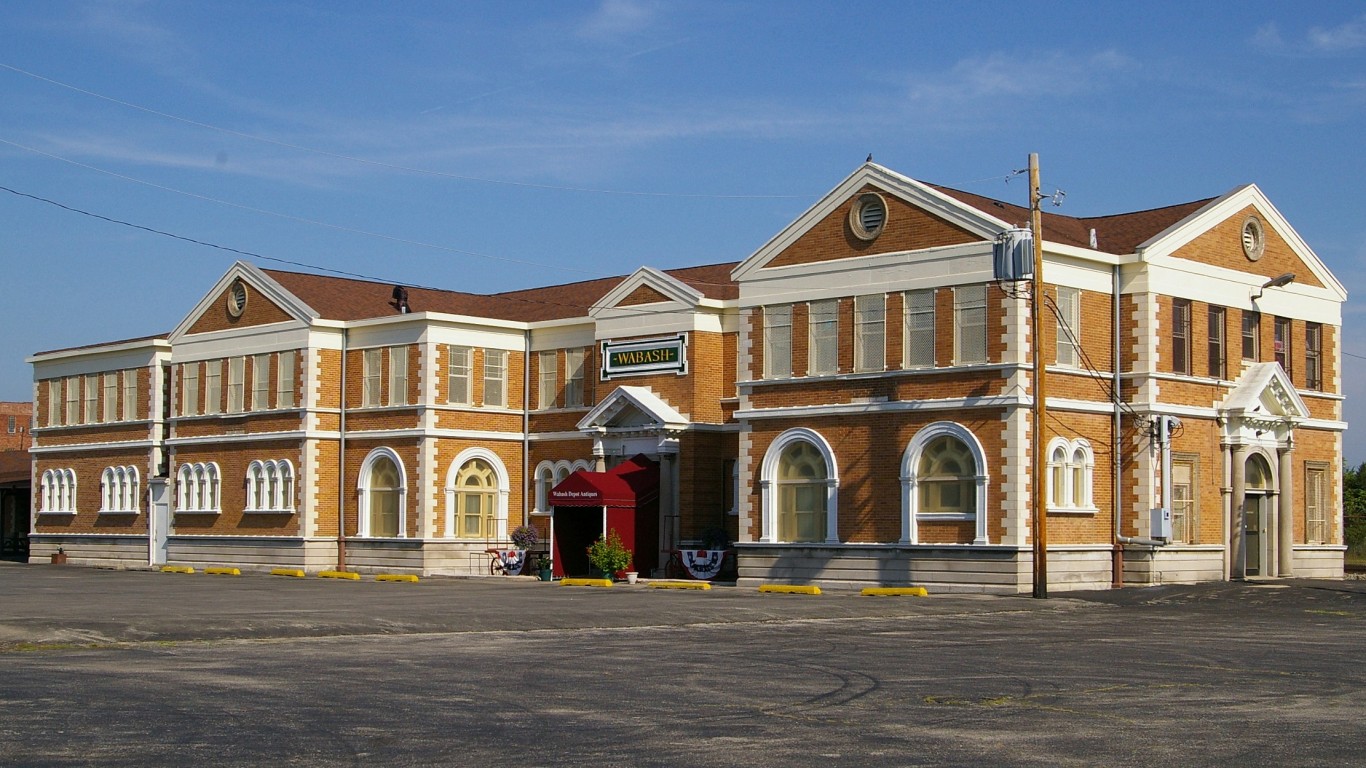
Illinois: Decatur
> Median household income: $41,440 (state: $69,187)
> Poverty rate: 24.4% (state: 11.5%)
> Median home value: $87,800 (state: $209,100)
> Adults with a bachelor’s degree: 20.7% (state: 35.8%)
> 2019 unemployment rate: 8.0% (state: 4.8%)
> Population: 69,553
With a median annual household income of $41,440, Decatur is the poorest of the 19 cities in Illinois. The city’s median household income is more than $5,000 lower than the next poorest city. Residents of Decatur, which is about 40 miles east of Springfield near the middle of Illinois, are more than twice as likely to live in poverty as the typical Illinois resident, with a 24.4% poverty rate.
Homes in Decatur have not just the lowest value of any Illinois city, but also among the lowest in the country. The typical U.S. home is worth over $240,000, and the typical Illinois home is worth nearly $210,000. In Decatur, the typical home is worth $87,800, lower than the median value of all but 13 other U.S. cities.
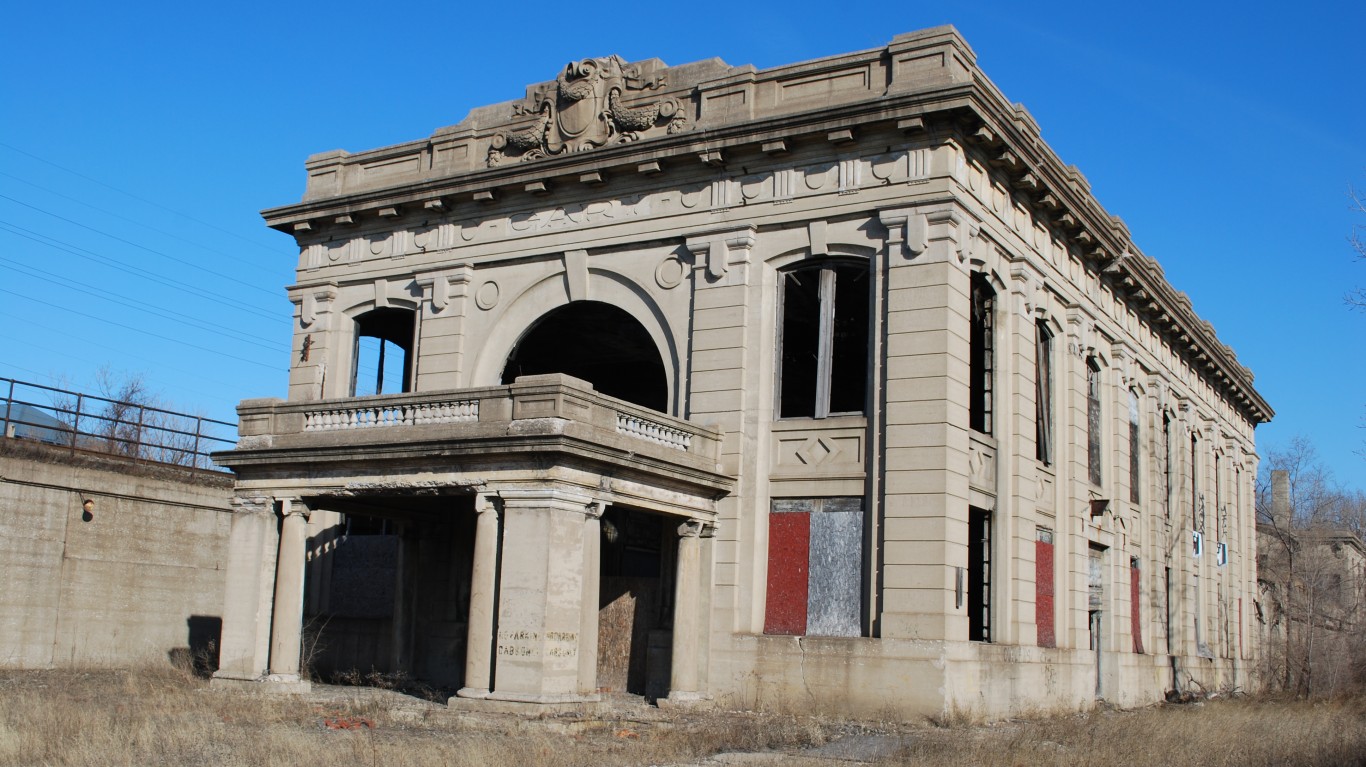
Indiana: Gary
> Median household income: $31,341 (state: $57,603)
> Poverty rate: 30.0% (state: 11.9%)
> Median home value: $63,800 (state: $156,000)
> Adults with a bachelor’s degree: 14.0% (state: 26.9%)
> 2019 unemployment rate: 12.6% (state: 4.2%)
> Population: 70,778
Gary, Indiana’s median annual household income of $31,341 is lower than the median in all other major U.S. cities, except for one. The city’s poverty rate of 30% and unemployment rate of 12.6% are each more than double the statewide and nationwide rates and rank among the highest of all 621 major U.S. cities.
Home prices generally reflect what people in the area can afford to pay, and homes in Indiana tend to have relatively low values. The typical home in the state is worth $156,000, well below the U.S. median of $240,500. And homes in Gary are worth even less than half of the Indiana median, at $63,800. Only a handful of other U.S. cities have lower median home prices.
[in-text-ad-2]

Iowa: Iowa City
> Median household income: $50,497 (state: $61,691)
> Poverty rate: 25.9% (state: 11.2%)
> Median home value: $243,500 (state: $158,900)
> Adults with a bachelor’s degree: 62.1% (state: 29.3%)
> 2019 unemployment rate: 4.0% (state: 3.7%)
> Population: 75,149
Most households in Iowa City earn less than $50,500 a year. Meanwhile, most households across the state earn at least $61,000 annually.
Incomes tend to rise with educational attainment, and the cities on this list tend to have relatively small college-educated populations. Iowa City is a notable exception, however. Home to the University of Iowa, Iowa City has a bachelor’s degree attainment rate of 62.1%. For context, only 33.1% of adults nationwide have a four year degree, and only 29.3% of adults in Iowa do. Student populations in cities with large universities tend to skew income and poverty data.

Kansas: Kansas City
> Median household income: $45,391 (state: $62,087)
> Poverty rate: 22.2% (state: 11.4%)
> Median home value: $99,700 (state: $163,200)
> Adults with a bachelor’s degree: 19.3% (state: 34.0%)
> 2019 unemployment rate: 5.7% (state: 3.8%)
> Population: 152,818
The typical household in Kansas City, Kansas, earns just $45,391 a year, the least of any city in the state by at least $5,000. In some cities in Kansas, like Olathe, most households earn over $90,000 a year.
A weak job market may partially explain the low median income in Kansas City. The average unemployment rate in the area in 2019 was 5.7% — well above the 3.8% statewide jobless rate.
[in-text-ad]

Kentucky: Bowling Green
> Median household income: $42,164 (state: $52,295)
> Poverty rate: 23.3% (state: 16.3%)
> Median home value: $183,600 (state: $151,700)
> Adults with a bachelor’s degree: 33.1% (state: 25.1%)
> 2019 unemployment rate: 5.8% (state: 4.8%)
> Population: 70,542
The $42,000 median annual household income in Kentucky is $10,000 lower than the statewide median and over $23,000 lower than the U.S. median household income of $65,712. Bowling Green also has the state’s highest poverty rate, at 23.3%, and the highest unemployment rate, at 5.8%.
Though it is the poorest city in Kentucky, the median home value in Bowling Green is over $180,000, more than $30,000 more than the state’s median home value. Also unlike many of the other cities on this list, Bowling Green has a higher bachelor’s degree attainment rate, at 33.1%, than the state as a whole.

Louisiana: Lake Charles
> Median household income: $37,894 (state: $51,073)
> Poverty rate: 26.7% (state: 19.0%)
> Median home value: $155,600 (state: $172,100)
> Adults with a bachelor’s degree: 26.7% (state: 25.0%)
> 2019 unemployment rate: 5.1% (state: 5.5%)
> Population: 78,395
Lake Charles is the only city in Louisiana where most households earn less than $40,000 a year. Residents are also far more likely to live below the poverty line than people in Louisiana. The poverty rate in the city stands at 26.7%, compared to the 19.0% statewide poverty rate.
Real estate values are typically indicative of what local residents can afford. In Lake Charles, the typical home is worth $155,600, compared to the median home value across the state as a whole of $172,100.

Maine: Portland
> Median household income: $61,779 (state: $58,924)
> Poverty rate: 12.0% (state: 10.9%)
> Median home value: $334,200 (state: $200,500)
> Adults with a bachelor’s degree: 57.4% (state: 33.2%)
> 2019 unemployment rate: 3.1% (state: 3.5%)
> Population: 66,218
Portland is the only city in Maine for which the Census ACS has 2019 data, and it ranks as the poorest city in the state by default only. In fact, the typical household in the city earns an income of $61,779 a year — about $3,000 more than the typical Maine household.
Unlike many of the other cities on this list, Portland is home to a relatively well-educated population. Over half of all adults in the city have a bachelor’s degree or higher, compared to about one-third of all adults in Maine.
[in-text-ad-2]
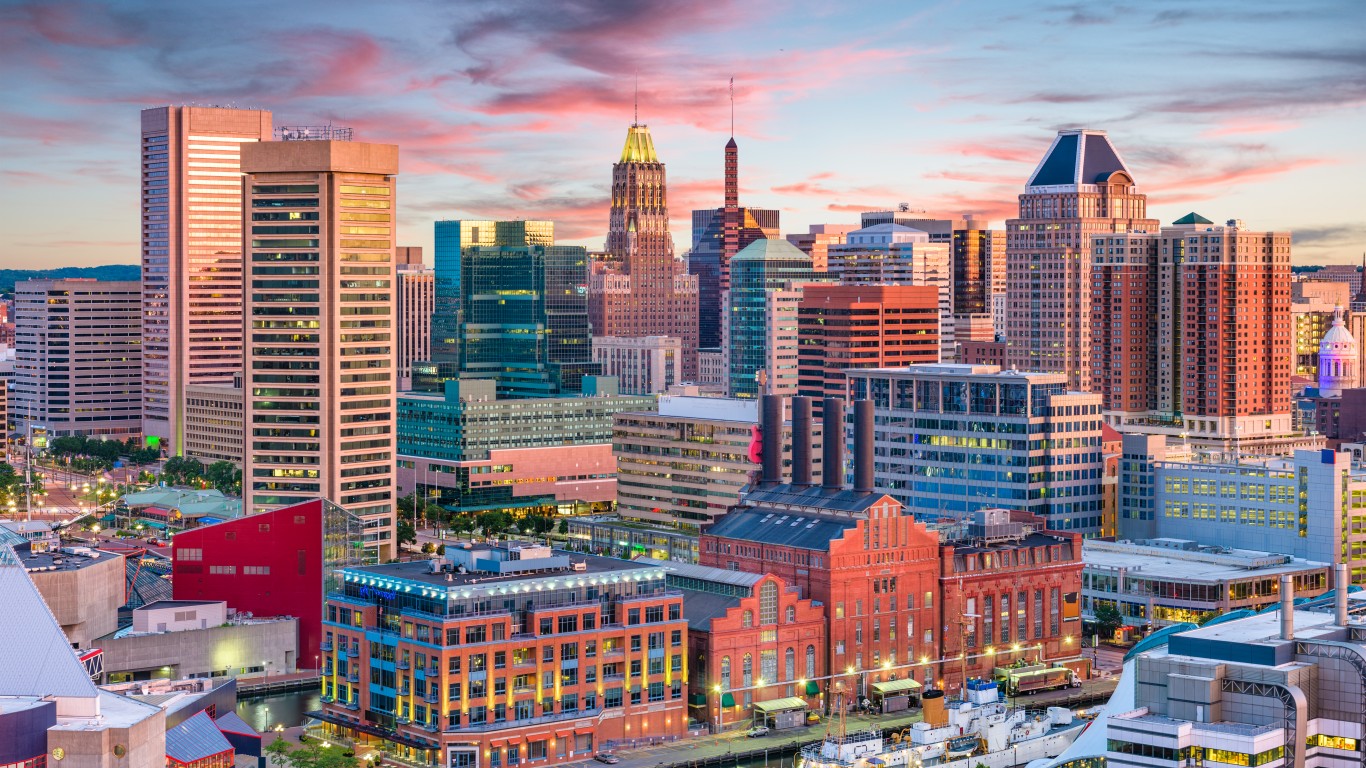
Maryland: Baltimore
> Median household income: $50,177 (state: $86,738)
> Poverty rate: 20.2% (state: 9.0%)
> Median home value: $179,100 (state: $332,500)
> Adults with a bachelor’s degree: 33.3% (state: 40.9%)
> 2019 unemployment rate: 7.3% (state: 4.5%)
> Population: 593,490
Baltimore is by far the poorest city in Maryland. The typical household in Baltimore earns $50,177 annually. The next poorest city in the state is Glen Burnie, where the typical household earns $83,883 annually. Residents of Maryland’s poorest city are also more than twice as likely as the typical Maryland resident to live below the poverty line.
The relatively large share of low-income households in Baltimore is likely attributable in part to a weak job market. The city’s annual unemployment rate stands at 7.3%, well above the 4.5% state jobless rate.

Massachusetts: Fall River
> Median household income: $41,346 (state: $85,843)
> Poverty rate: 24.5% (state: 9.4%)
> Median home value: $259,600 (state: $418,600)
> Adults with a bachelor’s degree: 15.7% (state: 45.0%)
> 2019 unemployment rate: 8.3% (state: 3.9%)
> Population: 89,534
Massachusetts ranks as the second richest state in the country after Maryland, with a median household income of nearly $86,000. Yet not all cities in the state are wealthy, as the median household income of Fall River, in the southern part of the state, is less than half that, at just over $41,000.
Nearly a quarter of Fall River residents live below the poverty line, as compared to 9.4% of state residents overall. College-educated Americans are more likely to hold high paying jobs. Massachusetts is the best educated state in the nation, with 45% of adults holding at least a bachelor’s degree. In Fall River, fewer than 16% of adults hold a bachelor’s degree.
[in-text-ad]
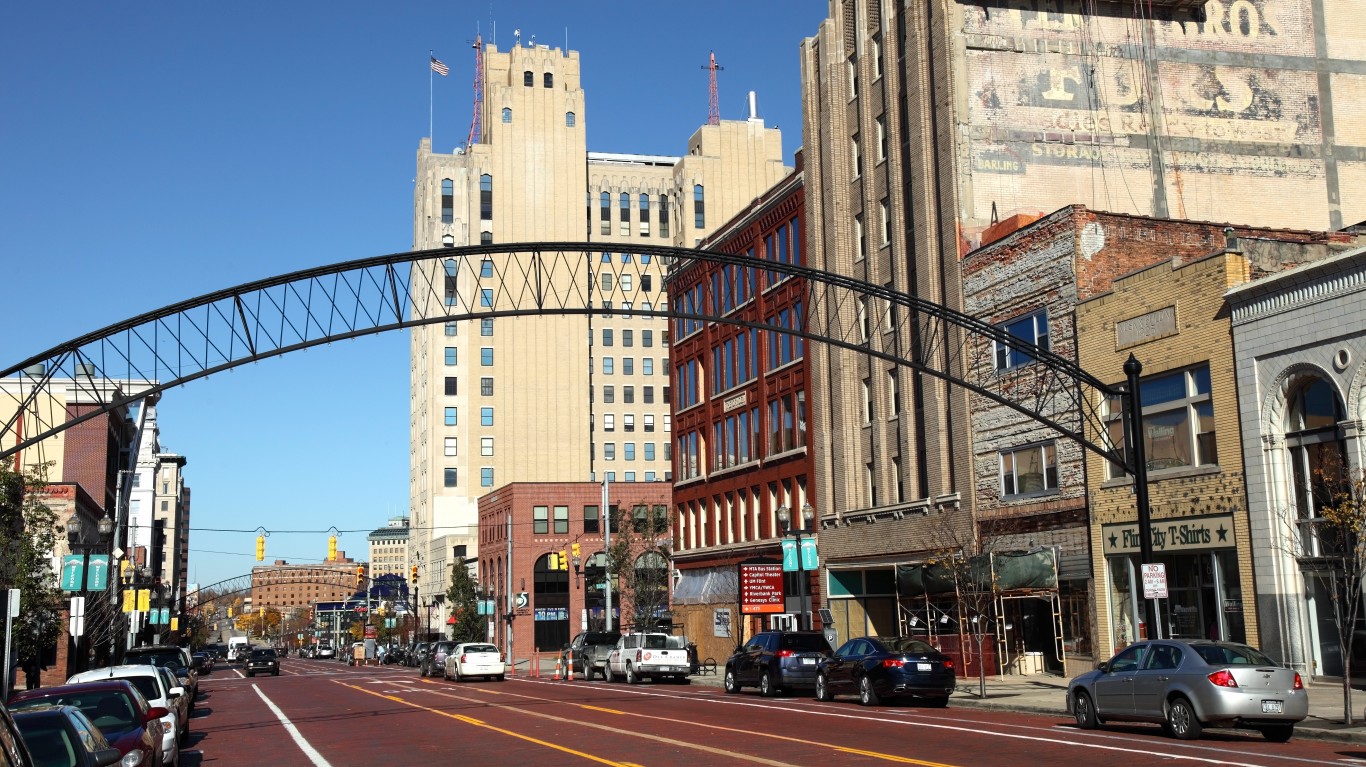
Michigan: Flint
> Median household income: $32,236 (state: $59,584)
> Poverty rate: 32.6% (state: 13.0%)
> Median home value: $34,400 (state: $169,600)
> Adults with a bachelor’s degree: 13.5% (state: 30.0%)
> 2019 unemployment rate: 17.3% (state: 5.0%)
> Population: 95,541
Flint ranks as the poorest city in Michigan and one of the poorest in the United States. The typical household in the city earns $32,236 a year, less than half the national median household income of $65,712 and well below the state’s median of $59,584.
The large share of Flint households struggling financially is attributable in part to a lack of jobs. The unemployment rate in the city in 2019 averaged 17.3%, the highest of any city in the country.
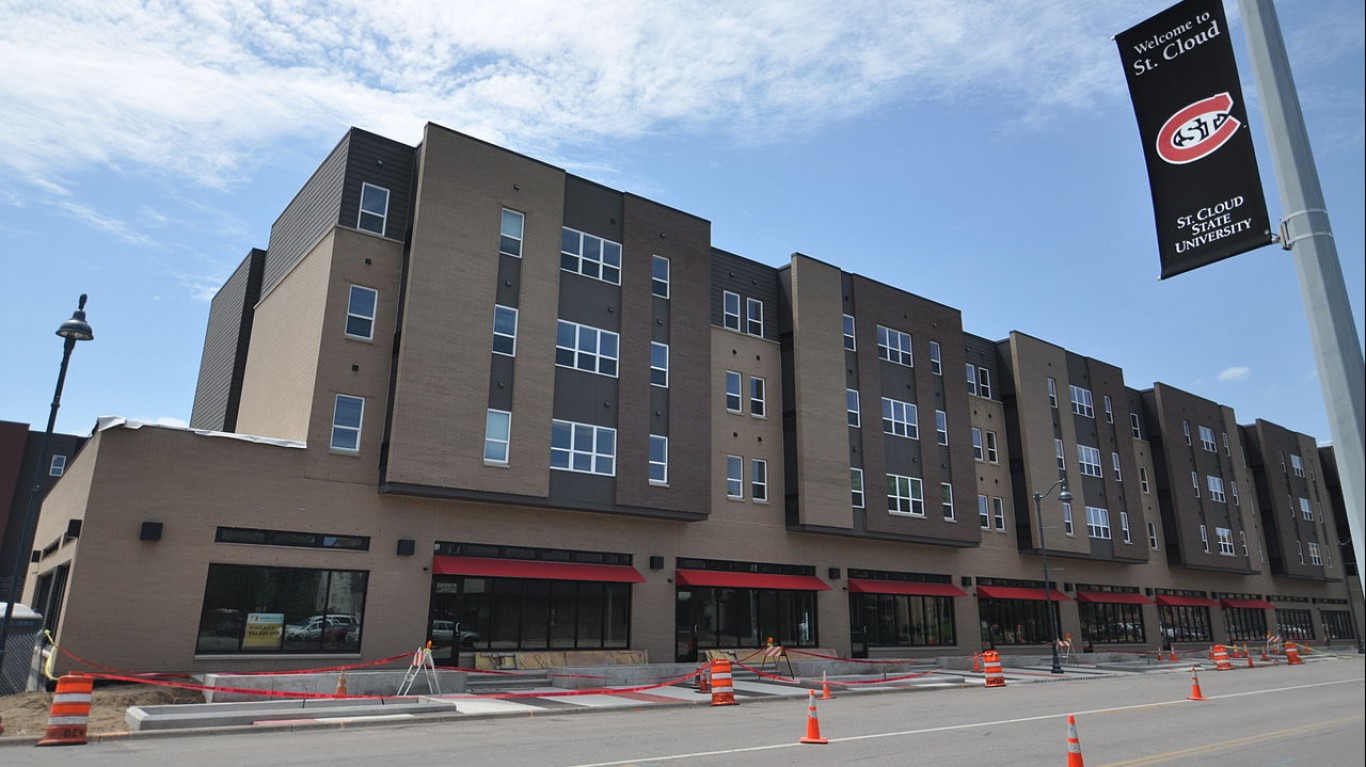
Minnesota: St. Cloud
> Median household income: $53,829 (state: $74,593)
> Poverty rate: 18.2% (state: 9.0%)
> Median home value: $169,500 (state: $246,700)
> Adults with a bachelor’s degree: 32.7% (state: 37.3%)
> 2019 unemployment rate: 4.0% (state: 3.2%)
> Population: 66,741
The median annual household income in St. Cloud, Minnesota, of $53,829 is nearly $21,000 less than the statewide median of $74,593. Housing prices in a given area typically mirror what residents can afford — and in St. Cloud, real estate is less expensive than it is in every other city in the state. The typical home in the city is worth $169,500, about $77,000 below the median home value of $246,700 across Minnesota.

Mississippi: Gulfport
> Median household income: $36,013 (state: $45,792)
> Poverty rate: 30.7% (state: 19.6%)
> Median home value: $123,800 (state: $128,200)
> Adults with a bachelor’s degree: 20.7% (state: 22.3%)
> 2019 unemployment rate: 10.6% (state: 6.6%)
> Population: 71,701
Gulfport is the poorest city in one of the poorest states. Across all of Mississippi, most households earn less than $46,000 a year, while nationwide, most households earn over $65,000 a year. Additionally, the national poverty rate of 12.3% is well below the 19.6% poverty rate in Mississippi and the 30.7% rate in Gulfport.
Incomes tend to rise with educational attainment. In Gulfport, just 20.7% of adults have a bachelor’s degree or higher, compared to 22.3% of adults in Mississippi and 33.1% of adults nationwide.
[in-text-ad-2]

Missouri: Springfield
> Median household income: $35,677 (state: $57,409)
> Poverty rate: 20.9% (state: 12.9%)
> Median home value: $124,000 (state: $168,000)
> Adults with a bachelor’s degree: 26.2% (state: 30.2%)
> 2019 unemployment rate: 3.8% (state: 3.8%)
> Population: 167,864
The median annual household income in Springfield of $35,677 is more than $20,000 below the median income in Missouri as a whole. Springfield is by far the poorest major city in the state and the 11th poorest major city in America.
The Southwestern Missouri city’s poverty rate of 20.9% is well above the state and national poverty rates. Unlike many other cities on this list, Springfield has a relatively low unemployment rate, at 3.8%. This is in line with Missouri’s unemployment rate and below the national 4.5% unemployment rate for 2019.
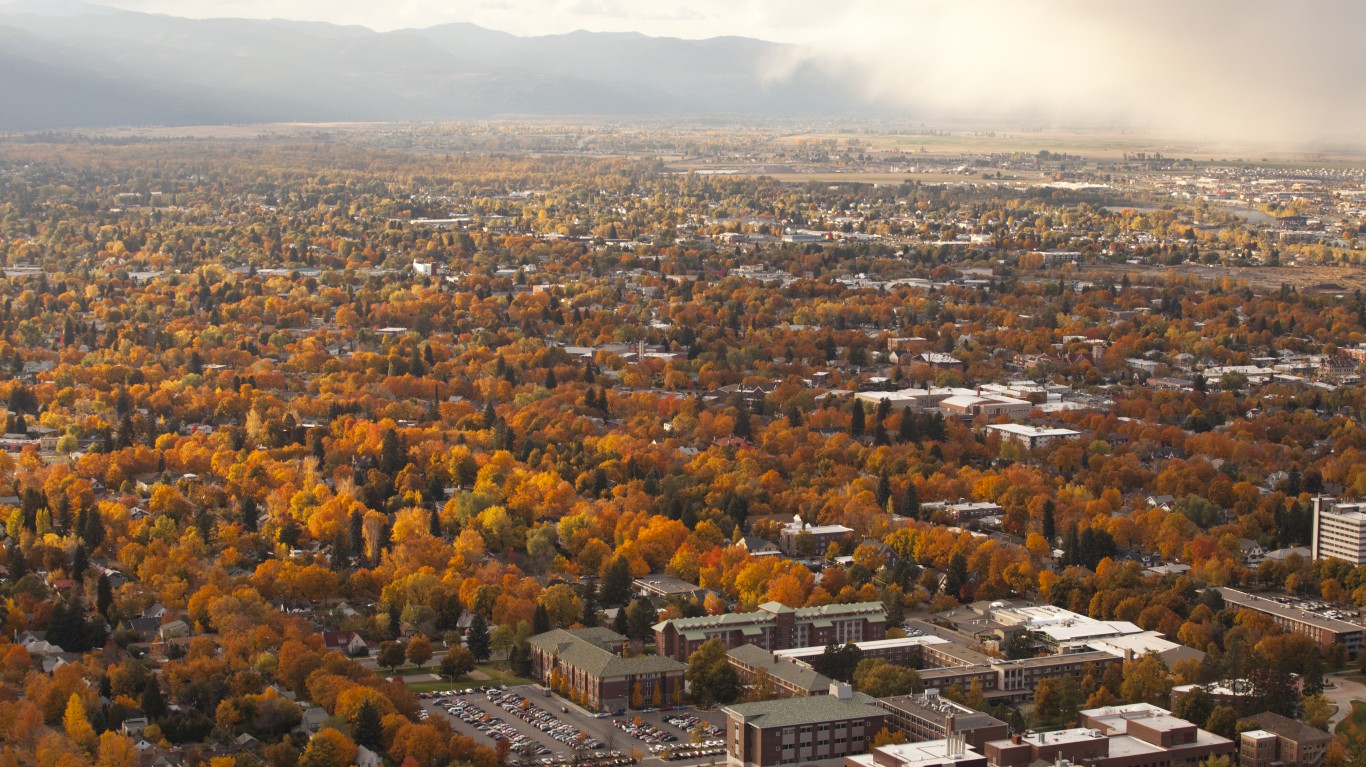
Montana: Missoula
> Median household income: $50,194 (state: $57,153)
> Poverty rate: 13.8% (state: 12.6%)
> Median home value: $317,800 (state: $253,600)
> Adults with a bachelor’s degree: 48.8% (state: 33.6%)
> 2019 unemployment rate: 6.2% (state: 4.1%)
> Population: 75,527
Missoula is one of just two major cities in Montana, along with Billings. With a median household income of $50,194 — over $8,000 lower than that of Billings — Missoula is the poorest city in Montana.
Missoula has a relatively high share of households living on less than $10,000 a year, at 6.0%, compared to 4.8% of Billings households. This contributes to the state-leading poverty rate of 13.8%.
[in-text-ad]
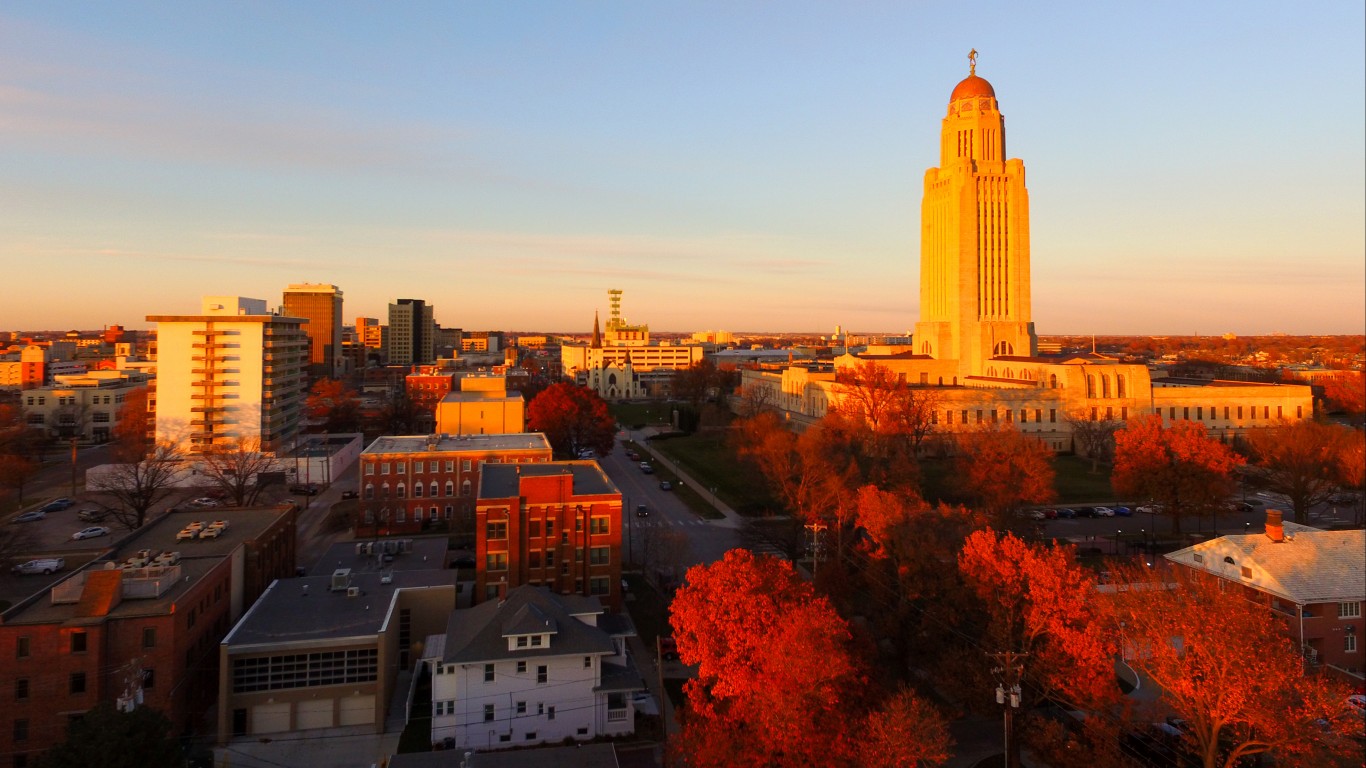
Nebraska: Lincoln
> Median household income: $59,228 (state: $63,229)
> Poverty rate: 11.8% (state: 9.9%)
> Median home value: $189,400 (state: $172,700)
> Adults with a bachelor’s degree: 40.4% (state: 33.2%)
> 2019 unemployment rate: 3.6% (state: 3.3%)
> Population: 289,096
Most households in Lincoln earn less than $60,000 a year. Meanwhile, most households across the state earn at least $63,000 annually.
Incomes tend to rise with educational attainment, and the cities on this list tend to have relatively small college-educated populations. Lincoln is a notable exception, however. Home to the University of Nebraska, Lincoln has a bachelor’s degree attainment rate of 40.4%. For context, only 33.1% of adults nationwide have a four year degree, and only 33.2% of adults in Nebraska do. Student populations in cities with large universities tend to skew the area’s income and poverty data.
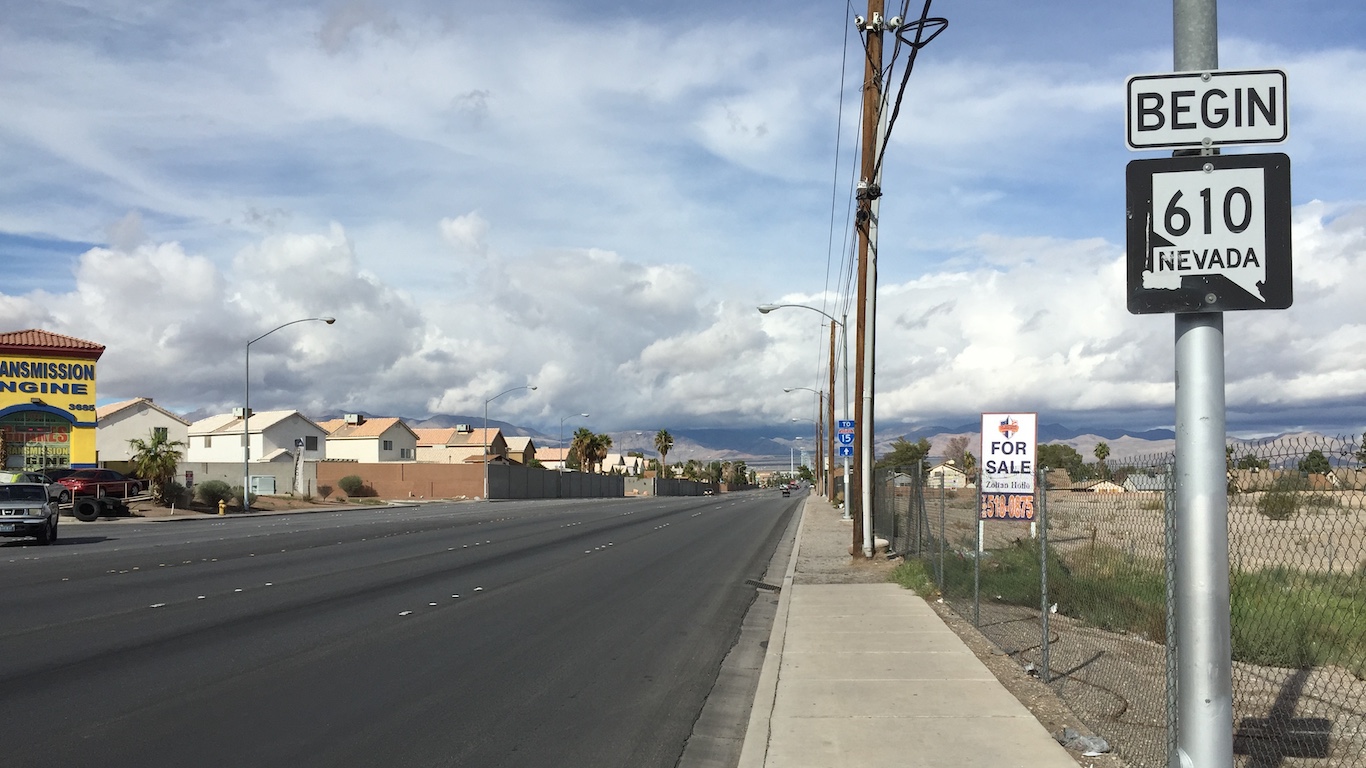
Nevada: Sunrise Manor
> Median household income: $44,422 (state: $63,276)
> Poverty rate: 20.6% (state: 12.5%)
> Median home value: $226,400 (state: $317,800)
> Adults with a bachelor’s degree: 10.5% (state: 25.7%)
> 2019 unemployment rate: 7.2% (state: 5.1%)
> Population: 192,968
Sunrise Manor, Nevada, is a Census designated place just outside of Las Vegas. With a median household income of $44,422, it ranks as the poorest place in the state and the only place in Nevada where most households earn less than $50,000 annually.
Incomes tend to rise with educational attainment and in Sunrise Manor, only about one in every 10 adults have a bachelor’s degree or higher. Across all of Nevada, about one in every four adults have a four year college degree.
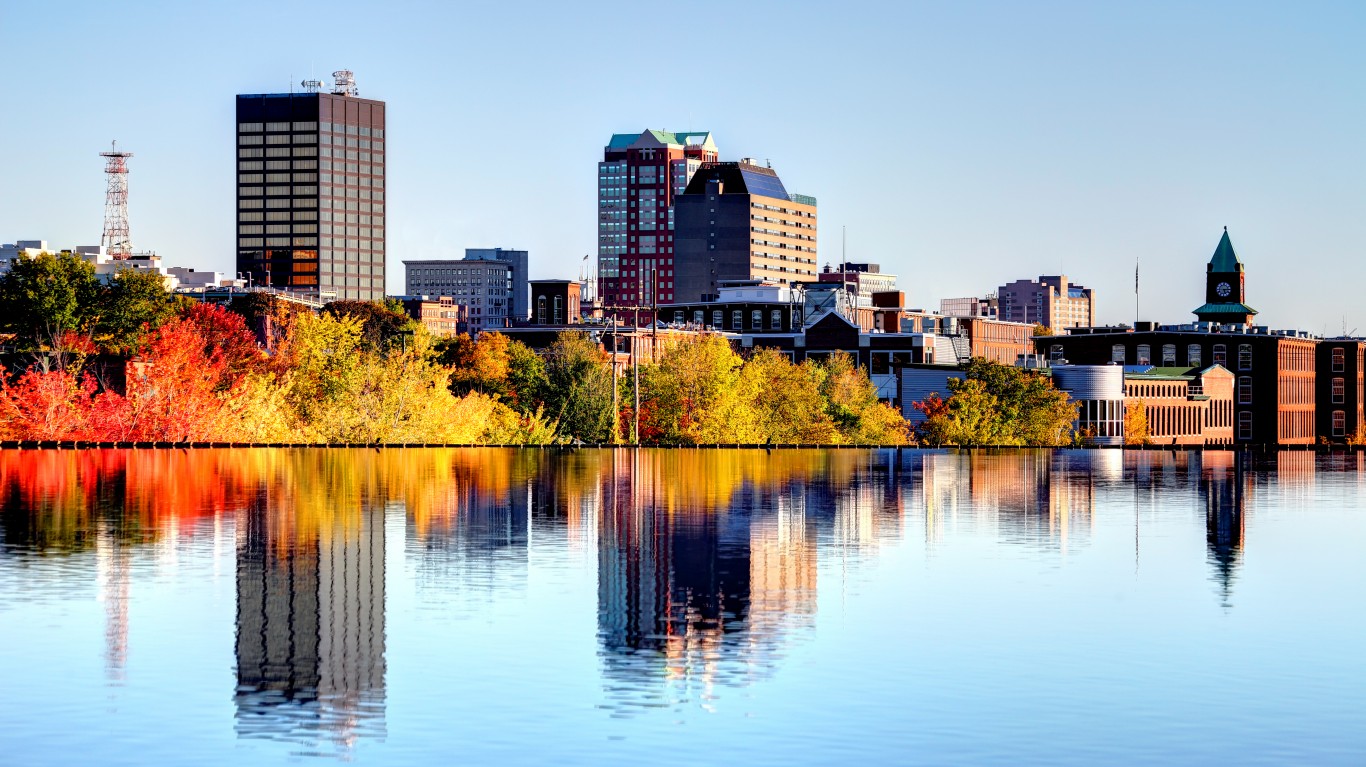
New Hampshire: Manchester
> Median household income: $64,162 (state: $77,933)
> Poverty rate: 12.3% (state: 7.3%)
> Median home value: $253,900 (state: $281,400)
> Adults with a bachelor’s degree: 31.7% (state: 37.6%)
> 2019 unemployment rate: 5.3% (state: 3.0%)
> Population: 112,658
The median household income of Manchester, New Hampshire, is $64,162 — trailing both the statewide median and the median of Nashua, the only other major city in the state, by about $14,000. The poverty rate in Manchester of 12.3% is 5 percentage points higher than the statewide rate but is in line with the U.S. poverty rate.
Workers with college degrees tend to earn more than workers with lower levels of education, and Manchester has a lower bachelor’s degree attainment rate than both Nashua and the state as a whole.
[in-text-ad-2]
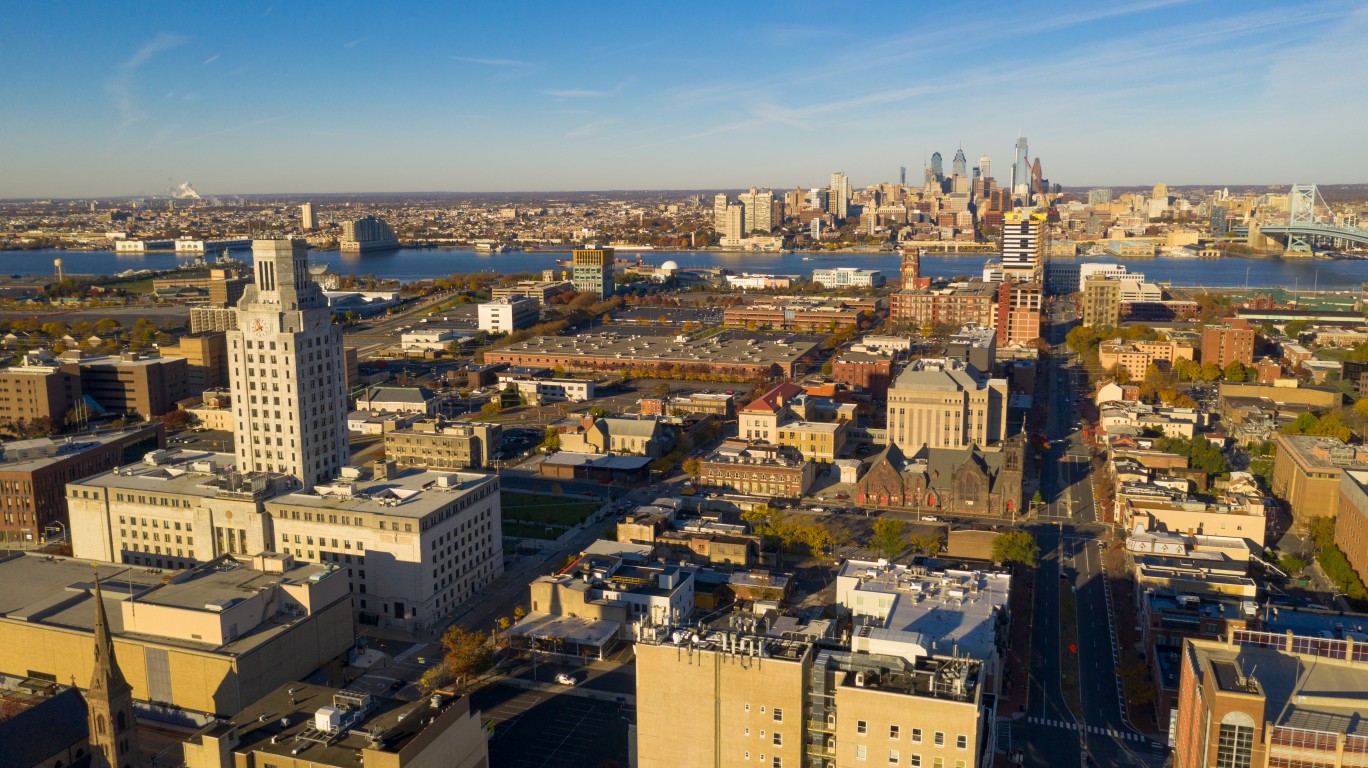
New Jersey: Camden
> Median household income: $33,120 (state: $85,751)
> Poverty rate: 28.6% (state: 9.2%)
> Median home value: $88,600 (state: $348,800)
> Adults with a bachelor’s degree: 9.0% (state: 41.2%)
> 2019 unemployment rate: N/A (state: 4.7%)
> Population: 73,560
New Jersey has the largest gap of any state between median household incomes in the state and in its poorest city. The typical household in New Jersey earns $85,751 a year, nearly $53,000 more than the typical household in Camden.
Despite ranking as the poorest city in the state, Camden reported a significant reduction in poverty in 2019. The city’s poverty rate now stands at 28.6% — down from 40.9% in 2018.

New Mexico: Las Cruces
> Median household income: $45,130 (state: $51,945)
> Poverty rate: 22.2% (state: 18.2%)
> Median home value: $165,300 (state: $180,900)
> Adults with a bachelor’s degree: 33.6% (state: 27.7%)
> 2019 unemployment rate: 8.1% (state: 5.5%)
> Population: 103,436
Incomes are far lower across New Mexico than they are nationwide. The typical household in the state earns $51,945 a year, well below the national household median of $65,712. In Las Cruces, where most households earn less than $45,200 a year, incomes are even lower.
Though Las Cruces has the lowest median income of any city in the state, incomes have risen significantly in the city recently. As recently as 2018, the median household income in Las Cruces was just $35,924.
[in-text-ad]

New York: Rochester
> Median household income: $37,711 (state: $72,108)
> Poverty rate: 25.3% (state: 13.0%)
> Median home value: $87,000 (state: $338,700)
> Adults with a bachelor’s degree: 28.2% (state: 37.8%)
> 2019 unemployment rate: 6.0% (state: 4.4%)
> Population: 205,704
Though New York is one of the wealthiest states, not all of its 11 major cities and places covered by the 2019 ACS have high incomes. Rochester’s median household income of $37,711 is lower than all but 20 other U.S. cities. Rochester, just south of Lake Ontario in Western New York, has a poverty rate over 25%, nearly double the statewide poverty rate.
Home prices in a region typically reflect what area residents can afford, and in Rochester, most homes are very inexpensive. The city’s median home value of $87,000 is a fraction of the statewide median home value of $338,700 and the U.S. median of $240,500.
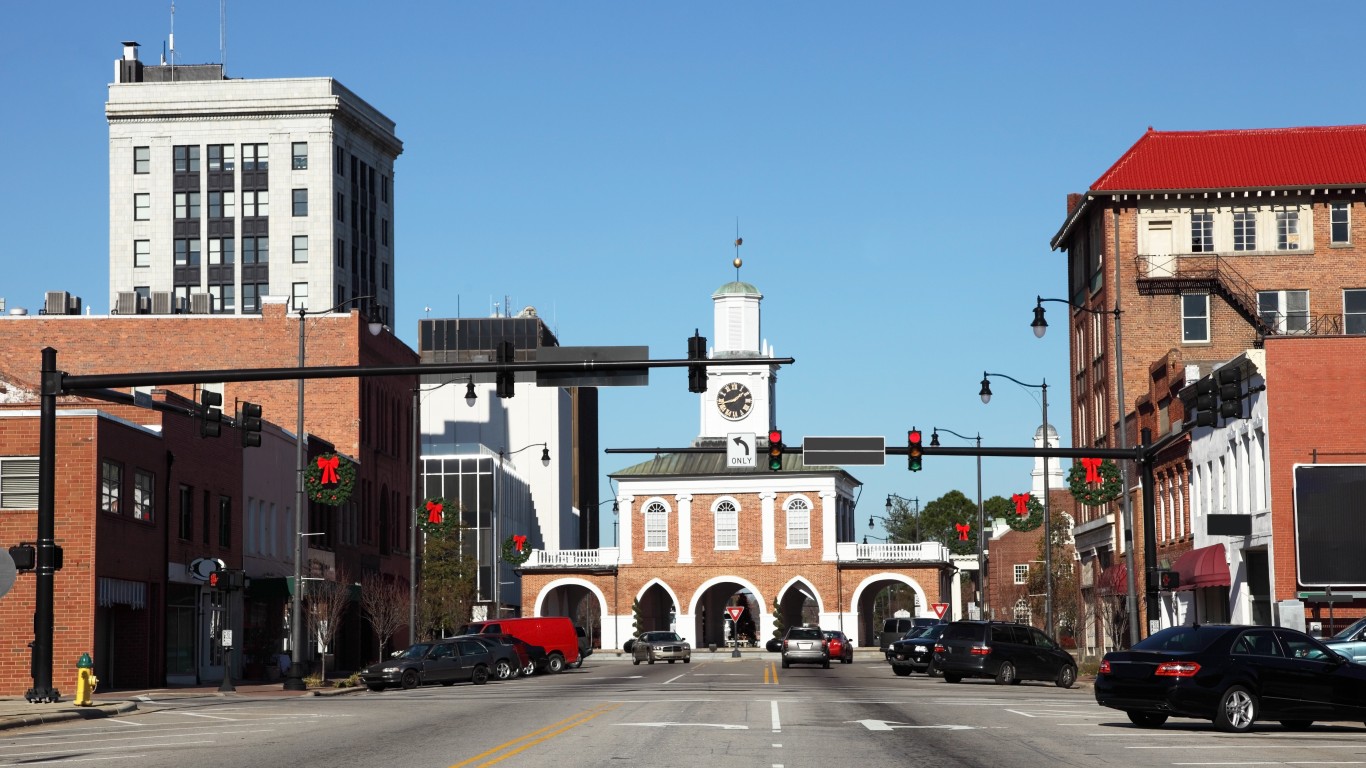
North Carolina: Fayetteville
> Median household income: $43,789 (state: $57,341)
> Poverty rate: 19.3% (state: 13.6%)
> Median home value: $128,000 (state: $193,200)
> Adults with a bachelor’s degree: 26.8% (state: 32.3%)
> 2019 unemployment rate: 7.9% (state: 4.6%)
> Population: 211,674
Fayetteville, North Carolina, ranks as the poorest city in the state. The typical household in the city earns just $43,789 a year, well below the statewide median income of $57,341. The low median income in the area is likely partially a product of a weak job market. An average of 7.9% of the Fayetteville labor force was unemployed in 2019, well above the comparable 4.6% unemployment rate across North Carolina over the same period.

North Dakota: Fargo
> Median household income: $52,810 (state: $64,577)
> Poverty rate: 16.1% (state: 10.6%)
> Median home value: $236,800 (state: $205,400)
> Adults with a bachelor’s degree: 39.3% (state: 30.4%)
> 2019 unemployment rate: 2.8% (state: 2.6%)
> Population: 123,736
Fargo, one of just two North Dakota cities covered in the 2019 ACS, is the poorest city in the state as most households earn less than $53,000 in a year. The median household income in North Dakota’s other large city, Bismarck, is over $65,000.
Though Fargo’s 2019 unemployment rate, at 2.8%, was higher than North Dakota’s rate, it was still one of the lower unemployment rates in the nation, and well below the 4.5% U.S. rate. Yet Fargo’s poverty rate of 16.1% is much higher than North Dakota’s 10.6% poverty rate.
[in-text-ad-2]

Ohio: Youngstown
> Median household income: $29,143 (state: $58,642)
> Poverty rate: 37.9% (state: 13.1%)
> Median home value: $50,200 (state: $157,200)
> Adults with a bachelor’s degree: 16.7% (state: 29.3%)
> 2019 unemployment rate: 13.7% (state: 4.6%)
> Population: 65,479
Youngstown is the poorest city not only in Ohio but the entire country. It is the only city in the U.S. where most households earn less than $30,000 a year. Additionally, 37.9% of the Youngstown population lives below the poverty line compared to 13.1% of the Ohio population and 12.3% of all Americans.
A Rust Belt city, Youngstown’s job market has been hollowed out with the decline of American manufacturing. Unemployment stood at 13.7% in the city in 2019, more than double the 4.6% statewide jobless rate.
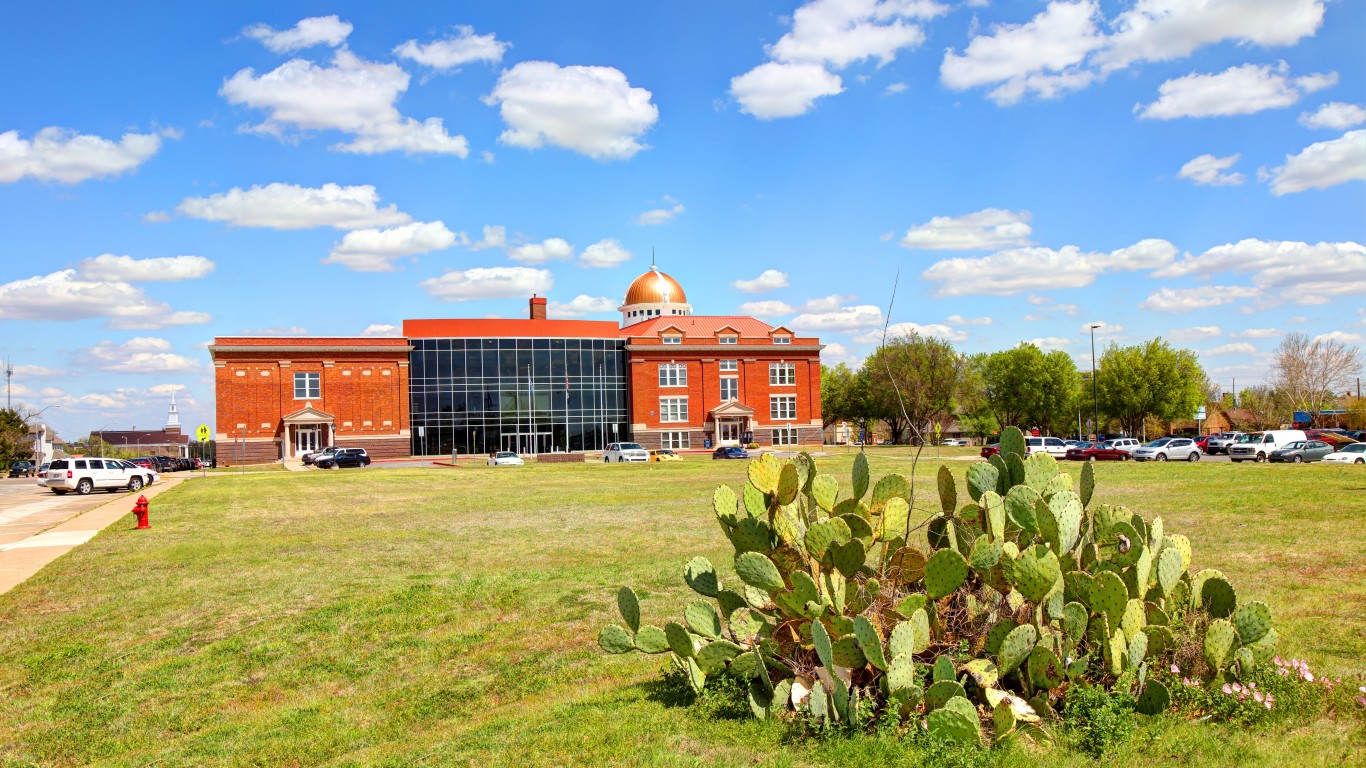
Oklahoma: Lawton
> Median household income: $46,886 (state: $54,449)
> Poverty rate: 20.4% (state: 15.2%)
> Median home value: $116,700 (state: $147,000)
> Adults with a bachelor’s degree: 20.8% (state: 26.2%)
> 2019 unemployment rate: 8.0% (state: 4.4%)
> Population: 93,026
Lawton, a small city in southern Oklahoma, ranks as the poorest city in the state with a median annual household income of $46,886. In most cities in the state, the median household income exceeds $50,000.
Incomes tend to rise with educational attainment, and not only is Lawton the poorest city in the state, but also the city with the lowest bachelor’s degree attainment rate. Just 20.8% of adults in Lawton have a four-year college education, compared to 26.2% of adults across the state as a whole.
[in-text-ad]

Oregon: Eugene
> Median household income: $51,269 (state: $67,058)
> Poverty rate: 17.3% (state: 11.4%)
> Median home value: $329,000 (state: $354,600)
> Adults with a bachelor’s degree: 42.6% (state: 34.5%)
> 2019 unemployment rate: 7.1% (state: 5.0%)
> Population: 172,614
The typical household in Eugene, Oregon, earns $51,269 a year, about $16,000 less than the median annual household income across the state as a whole.
Incomes tend to rise with educational attainment, and the cities on this list tend to have relatively small college-educated populations. Eugene is a notable exception, however. Home to the University of Oregon, Eugene has a bachelor’s degree attainment rate of 42.6%. For context, only 33.1% of adults nationwide have a four year degree, and only 34.5% of adults in Oregon do. The large student population in Eugene likely skews the city’s median household income downward.
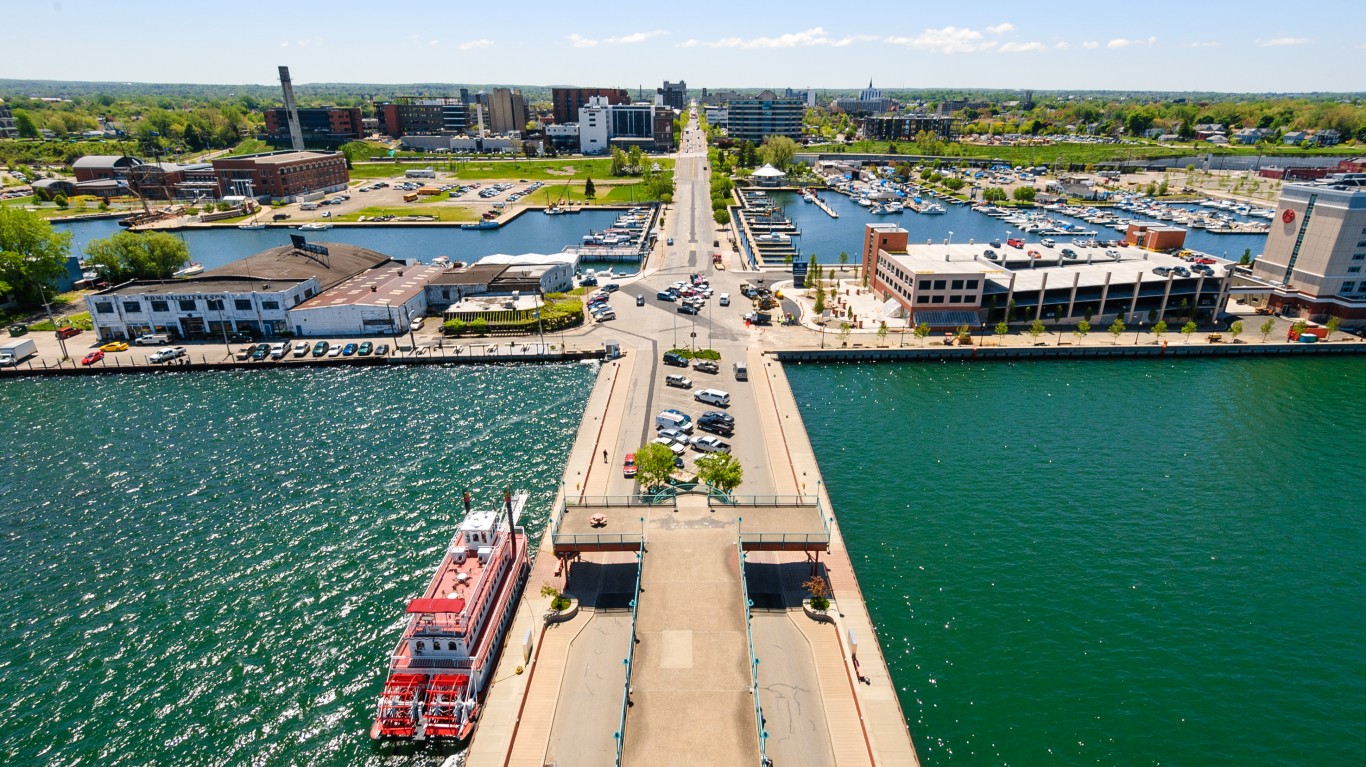
Pennsylvania: Erie
> Median household income: $35,798 (state: $63,463)
> Poverty rate: 28.5% (state: 12.0%)
> Median home value: $91,200 (state: $192,600)
> Adults with a bachelor’s degree: 22.3% (state: 32.3%)
> 2019 unemployment rate: 7.8% (state: 4.5%)
> Population: 95,537
The typical household in Erie earns just $35,798 a year, nearly $28,000 less than the median household income of $63,463 across all of Pennsylvania. Lower-income areas tend to also have lower property values, and Erie is no exception. Most homes in the area are worth just $91,200 or less — over $100,000 below the statewide median home value of $192,600.
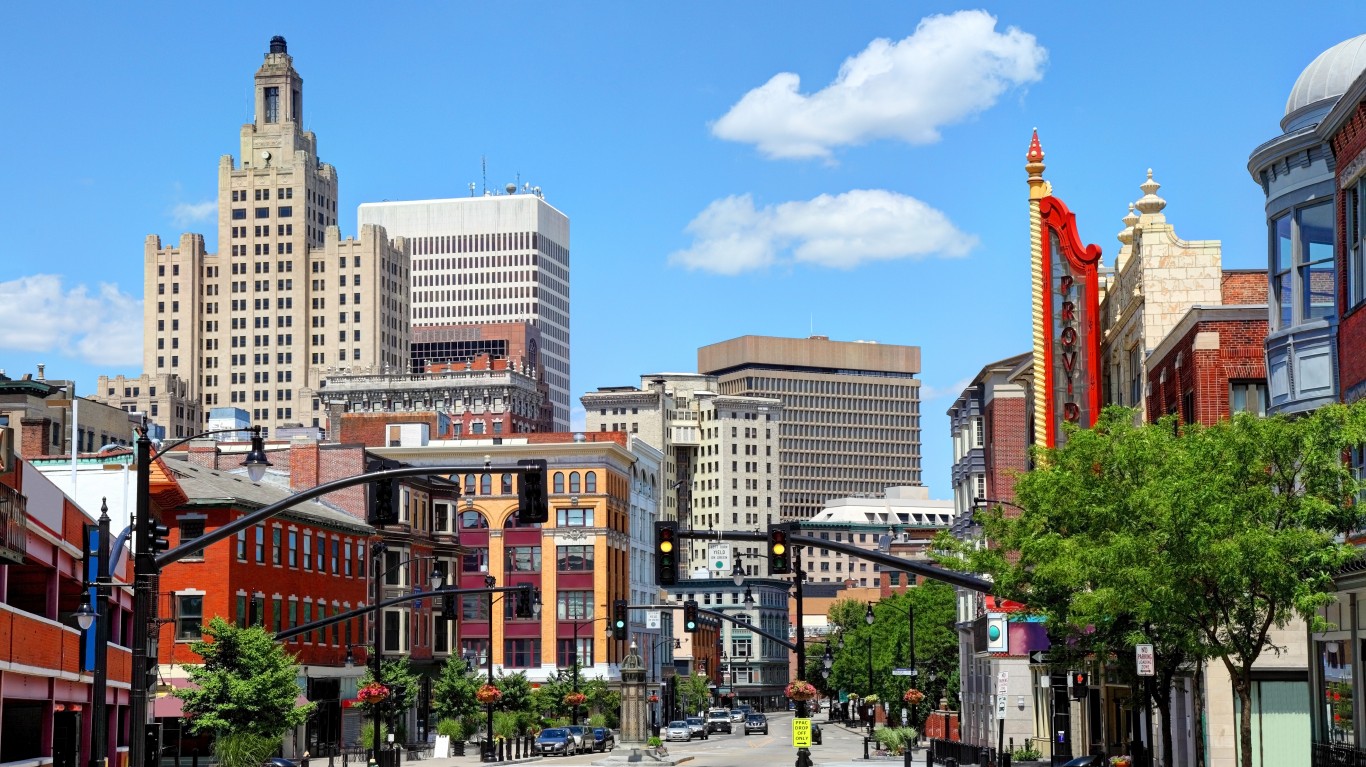
Rhode Island: Providence
> Median household income: $50,097 (state: $71,169)
> Poverty rate: 22.6% (state: 10.8%)
> Median home value: $237,200 (state: $283,000)
> Adults with a bachelor’s degree: 33.2% (state: 34.8%)
> 2019 unemployment rate: 6.9% (state: 4.2%)
> Population: 179,875
The typical household in Providence earns $50,097 a year, less than every other city in Rhode Island and about $25,000 less than the median household income in Warwick, a smaller city about 10 miles south of the state capital.
As is often the case in the cities on this list, unemployment is far more common in Providence than it is across the rest of the state. An estimated 6.9% of the local labor force were unemployed in 2019, compared to 4.2% of the labor force in all of Rhode Island.
[in-text-ad-2]

South Carolina: Columbia
> Median household income: $47,386 (state: $56,227)
> Poverty rate: 22.5% (state: 13.8%)
> Median home value: $201,500 (state: $179,800)
> Adults with a bachelor’s degree: 45.9% (state: 29.6%)
> 2019 unemployment rate: 4.2% (state: 4.7%)
> Population: 131,323
Columbia, the South Carolina capital, ranks as the poorest city in the state. The city’s median household income of $47,386 is the lowest of any South Carolina and its 22.5% poverty rate is the highest.
Incomes tend to rise with educational attainment, and the cities on this list tend to have relatively small college-educated populations. Columbia is a notable exception, however. Home to the University of South Carolina, Columbia has a bachelor’s degree attainment rate of 45.9%. For context, only 33.1% of adults nationwide have a four year degree, and only 29.6% of adults in South Carolina do. The large student population in Columbia likely skews the city’s median household income downward.

South Dakota: Rapid City
> Median household income: $51,296 (state: $59,533)
> Poverty rate: 13.7% (state: 11.9%)
> Median home value: $207,300 (state: $185,000)
> Adults with a bachelor’s degree: 33.0% (state: 29.7%)
> 2019 unemployment rate: 5.8% (state: 3.0%)
> Population: 77,496
The median household income in Rapid City, South Dakota, of $51,296 is about $10,000 below the median household income in Sioux Falls — the only other city in the state covered by the 2019 ACS. Rapid City’s lower median income is likely due in part to a weak job market. An average of 5.8% of the city’s labor force were unemployed in 2019, compared to just 2.1% in Sioux Falls and 3.0% across the state as a whole.
[in-text-ad]
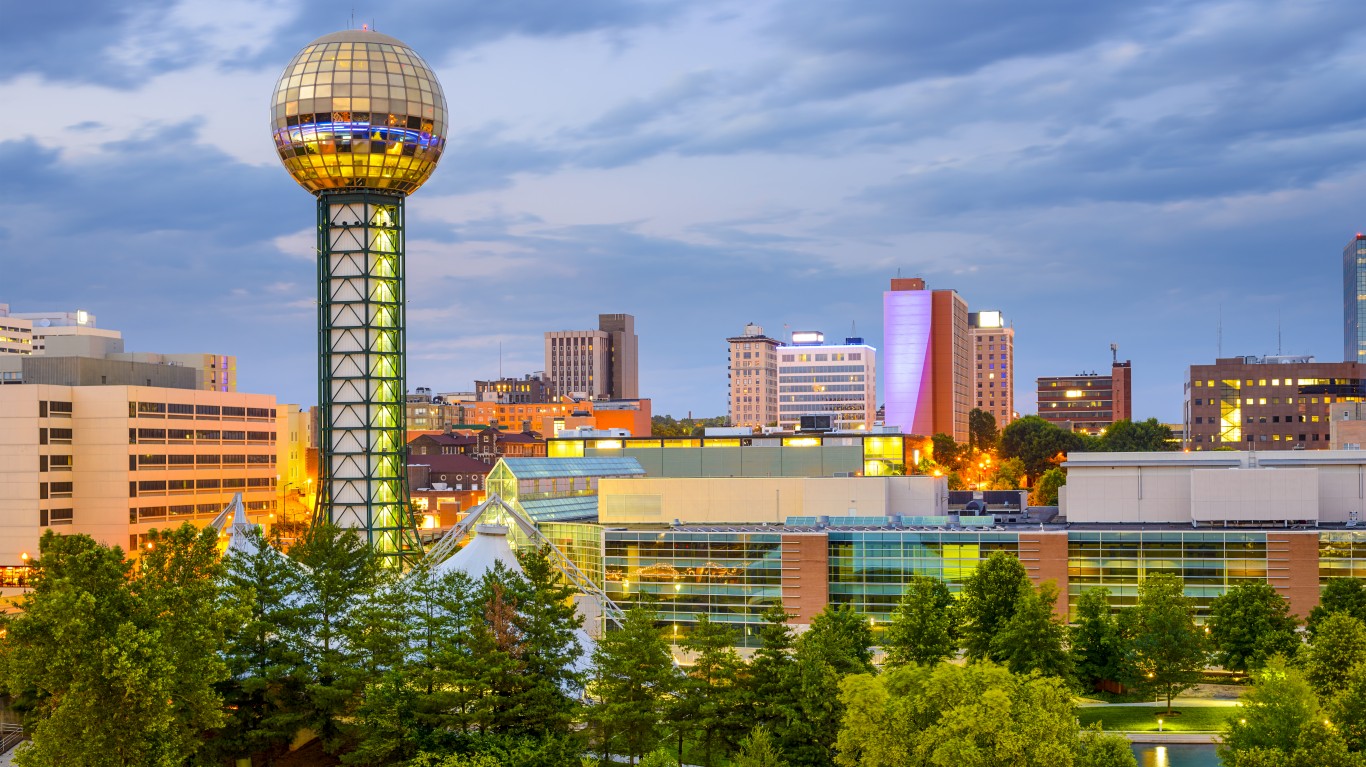
Tennessee: Knoxville
> Median household income: $41,388 (state: $56,071)
> Poverty rate: 21.8% (state: 13.9%)
> Median home value: $155,400 (state: $191,900)
> Adults with a bachelor’s degree: 32.9% (state: 28.7%)
> 2019 unemployment rate: 4.4% (state: 4.5%)
> Population: 187,610
Knoxville has the lowest median annual household income of Tennessee’s nine major cities, at $41,388. The city has an outsized share of households living on very low income, as 11.1% of Knoxville households earn under $10,000 annually. Statewide, fewer than 10% of households have this level of income, and nationwide, just 5.8% do.
Though it ranks as Tennessee’s poorest city, Knoxville’s unemployment rate of 4.4% is actually slightly lower than the state and national rate of 4.5%.

Texas: Pharr
> Median household income: $36,342 (state: $64,034)
> Poverty rate: 38.1% (state: 13.6%)
> Median home value: $82,000 (state: $200,400)
> Adults with a bachelor’s degree: 13.1% (state: 30.8%)
> 2019 unemployment rate: N/A (state: 4.4%)
> Population: 79,115
Pharr, a small city in southern Texas, has a median annual household income of just $36,342, the lowest of any city in the state and about $28,000 below what the median household income across the state as a whole.
Adults with higher educational attainment typically earn higher than average incomes. In Pharr, only 13.1% of the 25 and older population have a four-year college degree, well below the 30.8% share of adults in the same age groups across all of Texas.

Utah: Provo
> Median household income: $53,864 (state: $75,780)
> Poverty rate: 24.7% (state: 8.9%)
> Median home value: $335,700 (state: $330,300)
> Adults with a bachelor’s degree: 45.3% (state: 34.8%)
> 2019 unemployment rate: 4.5% (state: 3.2%)
> Population: 116,616
With a median annual household income of $53,864, Provo, Utah, is the only one of the state’s 11 major cities with a median household income lower than $60,000. About 45 miles south of Salt Lake City, Provo is home to Brigham Young University, which may explain why the city’s bachelor’s degree attainment rate is so high, at 45.3%.
Provo residents are well more than twice as likely to live in poverty than Utahns overall, as 24.7% live below the poverty, compared to 8.9% of residents statewide. Despite the relatively low incomes and high poverty rate, Provo homes tend to be worth more than the typical home in Utah.
[in-text-ad-2]

Virginia: Roanoke
> Median household income: $45,838 (state: $76,456)
> Poverty rate: 20.6% (state: 9.9%)
> Median home value: $147,300 (state: $288,800)
> Adults with a bachelor’s degree: 23.8% (state: 39.6%)
> 2019 unemployment rate: 3.9% (state: 4.0%)
> Population: 99,143
Virginia is a relatively wealthy state. Most households in the state earn over $76,000 a year, about $10,000 more than the national median household income. Not all parts of the state are wealthier than the U.S. as a whole, however. In Roanoke, the median household income is just $45,838 annually. Roanoke also has a far higher than average poverty rate. About one in every five local residents live below the poverty line, compared to about one in every 10 Virginians who do.

Washington: Yakima
> Median household income: $44,292 (state: $78,687)
> Poverty rate: 20.3% (state: 9.8%)
> Median home value: $216,600 (state: $387,600)
> Adults with a bachelor’s degree: 17.3% (state: 37.0%)
> 2019 unemployment rate: 6.7% (state: 4.6%)
> Population: 93,638
Yakima is by far the poorest city in Washington state. The city’s median annual household income of $44,292 is over $8,000 below that of Spokane, the city with the second lowest median household income in the state, and well below the $78,687 state median. Yakima residents are more than twice as likely to live below the poverty line as Washington residents overall. The city’s unemployment rate is also tied for the highest of any city in the state.
College-educated workers tend to earn more than workers without a degree. Yakma residents 25 and older are less than half as likely to hold at least a bachelor’s degree as Washington residents of the same age.
[in-text-ad]
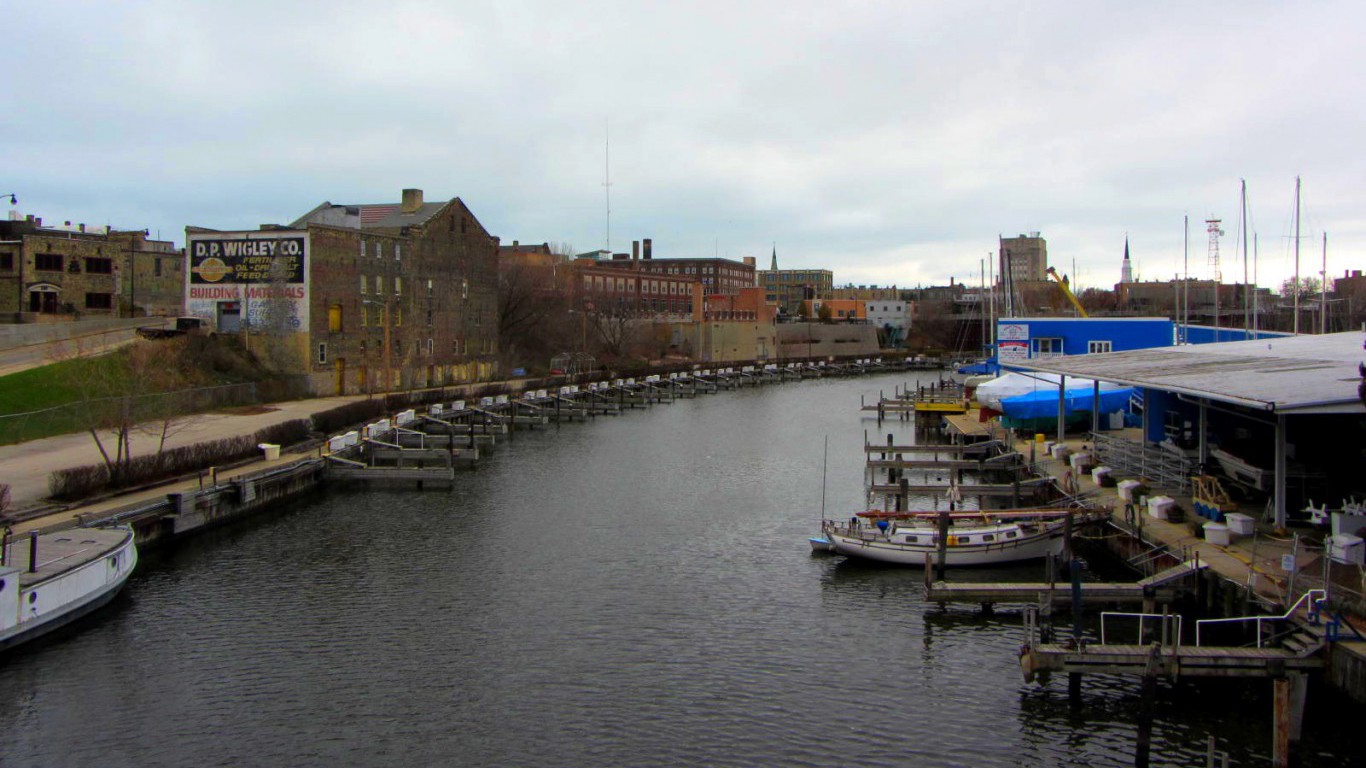
Wisconsin: Racine
> Median household income: $43,748 (state: $64,168)
> Poverty rate: 20.4% (state: 10.4%)
> Median home value: $124,500 (state: $197,200)
> Adults with a bachelor’s degree: 18.9% (state: 31.3%)
> 2019 unemployment rate: 5.2% (state: 3.2%)
> Population: 76,747
The median household income in Wisconsin is $64,168 annually, only slightly below the national median of $65,712. In some parts of the state, incomes are far lower than average, however. In Racine, a small city about 30 miles south of Milwaukee, most households earn less than $44,000 a year. The poorest city in the state, Racine’s poverty rate of 20.4% is nearly double the 10.4% poverty rate across Wisconsin as a whole.
Methodology:
To determine the poorest city in every state, 24/7 Wall St. reviewed 2019 median household incomes for all 621 U.S. cities, towns, villages, municipalities, and Census designated places with available data from the U.S. Census Bureau’s 2019 American Community Survey. Each of these places is home to at least 61,000 people. Vermont, West Virginia, and Wyoming have no cities covered in the latest Census release and were excluded from the analysis. Data on poverty, median home value, and population are also from the ACS and are one-year estimates for 2019.
Household income includes the income of the householder and all other individuals 15 years and over in the household, and is the sum of the amounts reported separately for wage or salary income; net self-employment income; interest, dividends, net rental, or royalty income; income from estates and trusts; Social Security or retirement income; Supplemental Security Income; public assistance or welfare payments; pensions; and all other income.
City boundaries are defined by the Census Bureau and adhere to the “place” geographical classification. Places can include municipalities, cities, towns, villages, and boroughs, as well as Census Designated Places, which are a statistical designation for unincorporated communities used by the Census Bureau. All figures listed are for 2019. All state figures referenced apply to the state the city is in and not the average of all states.
Thank you for reading! Have some feedback for us?
Contact the 24/7 Wall St. editorial team.
 24/7 Wall St.
24/7 Wall St. 24/7 Wall St.
24/7 Wall St. 24/7 Wall St.
24/7 Wall St.

